#a lack of context can create art
Explore tagged Tumblr posts
Text
i think when people say AI art is ''missing a soul'' it's just a simplified way to say it lacks what we basically consider human effort behind it, all the subconscious and conscious processes that lead someone to create are gone, the only purpose of the image is to be consumed and discarded because there isn't any emotional context behind it, no past, no process, nothing further to gain from it other than what the computer thinks majority of people find generically pleasing. i genuinely see no cultural purpose in such ''art'', there is absolutely nothing to be gained from it other than ''computer can also make pretty image now''
157 notes
·
View notes
Text
How to expand your vocabulary (in an enjoyable way).
Self-Awareness
If you find yourself struggling to find the appropriate words to express yourself ,then you need to learn more words. If you are reading this article or you find the title interesting, then you are closer than you thought. You are simply self aware. Self awareness is the first step to muster the courage to pursue the art of language and communication. It dawned on me that I was verbally malnourished when I could barely find the words to describe the character I read in a novel. "So what was he like?" My curious friends will ask and all I could say was "he had a troubled childhood and it was evident in his lack of self-control." The sound of that description even troubled me. I knew there was more to his character, but I restricted by my literary scarcity. I still struggle with this but I am making daily efforts to improve. This article will be prescriptive and descriptive.
Execution
Read books, I mean read actively. I read books and I atke pride in it but I am a severely passive reader. I barely engage with the story, the character, or the author's attempt to challenge my prejudice or affinity for the character. My reading goal was to read as many books as possible, quantity over quality. By quality, I mean quality of my reading, not the books per se. Now, I read differently (and I only started this a month ago), I read prudently, making stops anytime I encounter an unfamiliar word. I include that in my vocabulary list on my Notes app. after about 10 words or so. I immediately find each words synonyms, two per word; one easy, one difficult. For example, Decrepit (derelict, neglected).
Use Chat GPT to create sentences for you in different context and practice with that.

3. Find ways to include your new learned words in your own way. If you work a 9-5, it may be helpful to customize your prompt to business/professional context, to be more applicable to you. But most importantly, create your own sentence structure. If you have a meeting, prep for it by using the words your learned, take notes as a guide to help you effectively convey your ideas. I learned "impetuously" recently and during a meeting with my manager she asked me to access myself based on my strength and weaknesses. I responded with "I tend to impetuously accept projects without understanding the deliverables and I end up being overwhelmed with the expectations." My point it make sure you use the context of your everyday life. If you are a humanities major, you might approach this differently.
4. Make it enjoyable. Think of each new word as a specific dollar amount. Then create a "verbal bank," the more words your learn the richer you become. Ecah word for me is valued at $50. I earn $25 extra if I can use it effectively in a conversation. It you learn 10 new words a week, you have made yourself $500. Deposit that into your verbal bank!
5. Record yourself saying this words. Try to actively recall them but through a conversation. Do 1-minute tests. Record yourself describing your day, giving a presentation etc Notice with words flow naturally, if you like go back to your vocabulary list and test yourself. by creating sentences.
6. Expand your reading. Well, I did say to read books and I would suggest to go beyond. Read articles (very well written ones) and when not reading, actively listen to podcasts and pay attention to how the host convey their ideas. You would notice that good writing or speech is not necessarily peppered with difficult words. Good writers is simple to understand because the authors make diffiuclt topics or esoteric topics digestible.
Emulatate & Practise
You simply just have to emulate. Copy the style & syntax of people you admire or respect for their speech or writing. Keep practising. It is a choice to improve or not. Don't hold yourself back. I am practising by writing as well and I have barely scratched the surface and I am sure you can tell by my writing. It is not sophisticated but I do hope to improve and you can to.
Excite yourself
You will come to find yourself smiling when you read a text with words no longer foreign to you. Words that were once distant and strange will eventually become a part of you. That is the best feeling ever, it's exciting.
#self improvement#self love#growth#mindfulness#self development#education#emotional intelligence#self worth#self control#students#classy#smart wom#smart#book club#books#bookworm#reading#books and reading#self discipline
202 notes
·
View notes
Text
I’ve noticed that a lot of artists seem to channel their rahu placement in their early work, and then mature into their ketu placement as time passes
There is an instinctive urge to make art that is original or interesting in some way, in larger projects even an urge to worldbuild. Creation when you are an amateur often makes you want to reach outside the mundane you and express your ego (rahu).
But as artists get older and their work matures with them, art becomes less about making an imprint and ego and more so about self expression. In this context I mean self expression as in expressing everything you come from, and everything you already are at rest (ketu) when you aren’t rationalising yourself into being something else (rahu).
Ultimately it’s good to have a balance of both, and you wouldn’t be able to really separate them anyway since they work on an axis. Channeling your ketu artistically is important because it’s what comes naturally to you (for lack of better phrasing- ykwim). Using your rahu is also important because you need to understand the context in which you are creating, and to consume and intellectually digest the work of others around you.
When artists lean too hard into their ketu, their art can become a bit uncouth or controversial or at the very least out of touch.
When you lean too hard into your rahu, your work can become unoriginal as you’re too heavily influenced by what other people are doing.
#may follow this up with examples later#vedic astrology#nakshatra#rahu#ketu#rahu ketu#astrology#sidereal astrology
184 notes
·
View notes
Note
Hi, I found your work on Twitter last year and I really love and look up to your art. If you have the time, I wanted to as if there are there any study topics, artists or techniques that have significantly influenced you :')
I'm at a bit of a complete loss on what to study presently so I thought I'd ask my favorite artists, thank you for reading and I completely understand if this is too open ended a question
Thank you!
This isn't the first time I have been asked this question and I suspect this won't be the last so I'll just lay everything out here. Go to a cafe or get a blanket or something because this will not be a short read:
Foundational:
Anatomy: A lot of my foundational anatomy and clothing illustration knowledge was gained from taking classes and doing observational drawing. Because of this, I'm not going to have the best book recommendations but top 2 books I can recommend for getting Started started are Andrew Loomis or RockHe Kim's books on anatomy (huge asterisk here: they're good at teaching you Basics basics like muscle groups and turning forms and extremely general proportions but will not help that much with making your figure drawings less stiff or how to draw fat or especially in the latter's case how to draw women not built like stick bug anime girls but uh I heard the Morpho books are pretty good. genuinely everything I know about drawing fat is from observational drawing/studies because at some point I got sick of my school for only hiring skinny models in their 20s-30s). I have some diagrams drawn by my friend who studied the hell out of these guys below:

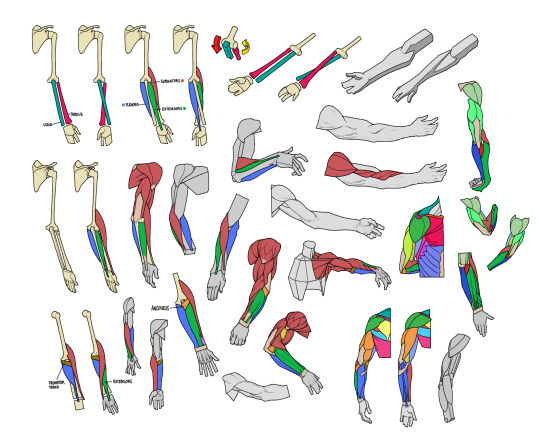


Clothing: I don't know any books that can really help on this front I apologize if I find any I'll update this post but pretty much all of my knowledge on drawing clothes boils down to the following rules: Where are the tension points, how stiff or soft is the textile, how is the form underneath the section of clothing behaving, and don't make even spaces between fold groups
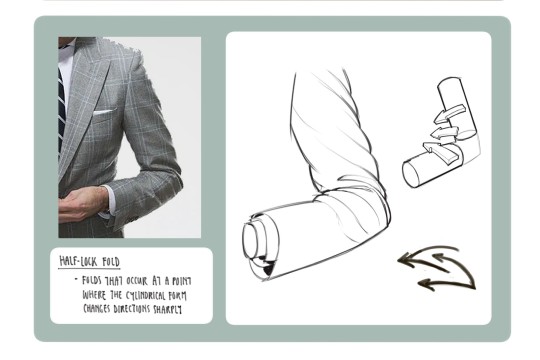
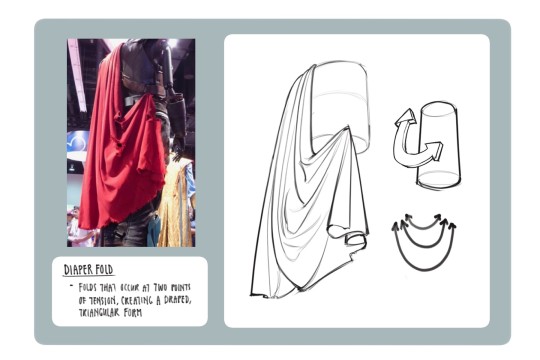
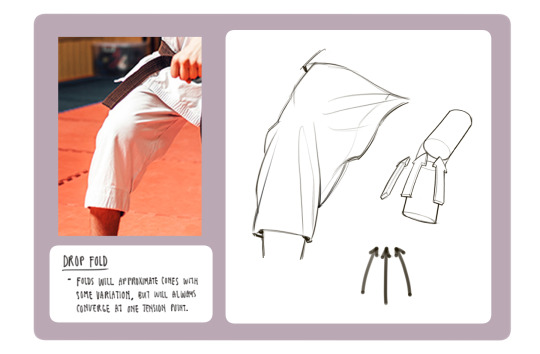
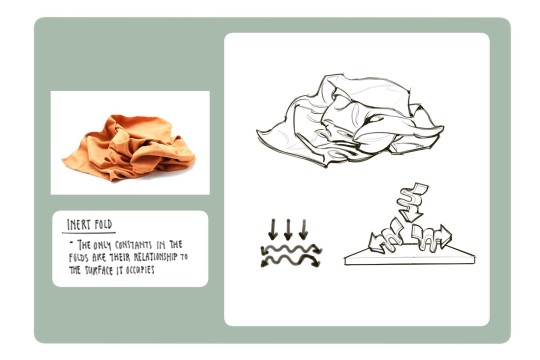
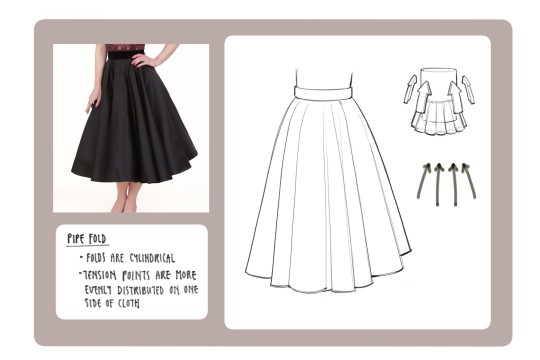
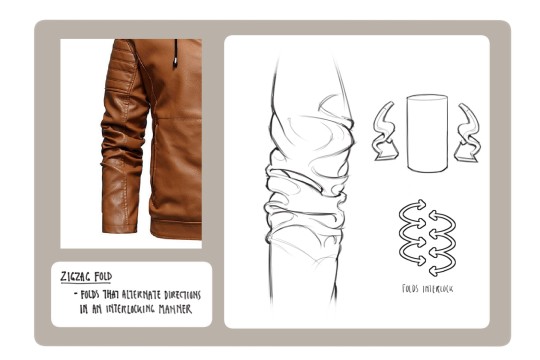
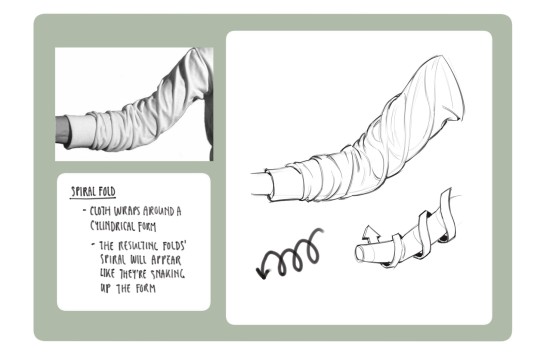
All of this is kind of moot though if it isn't applied through study or observational drawing though
Design:
I have to be really careful here because I don't want to deal in absolutes, the only absolute I'm confident espousing is that anyone who tells you there is only a small selection of methods you should follow to execute a specific type of design are objectively incorrect and just haven't figured out alternative if not more effective design solutions to a common problem. The only real Worst Thing I think you could do as a designer is create a pinterest mannequin devoid of a story, disconnected from its context in the world, and lacking in a clear purpose/personality but this too could be easily be disputed if maximising a character’s aesthetic appeal serves a purpose in its context, and my opposition to this design approach is my personal bias as a character designer for entertainment where emphasizing a character’s function and their relationship to said function is usually the goal
I think the 5 best pieces of advice I've ever received when it comes to designing characters are the following:
Try and follow the rule of thirds/general gestalt design principles of contrast
Always consider what it is you're trying to communicate with the character
Create believable transitions and reinforcements between points of interest
(Entertainment related) KISS principle/Keep It Simple, Stupid is your friend, the way a character wears or wields what they wear or wield will communicate their role in the world (who are they?), their relationship to their role (do they like their job? are they good at it? are they a part of an organization with the means to provide them things to perform their role more effectively?) effectively enough. Excessive information that bloats and conflicts with the communication objective weakens design (example: My favourite childhood toy for years was a pokemon plushie. Would I as a stay at home digital artist be wearing it as a keychain on my crusty paint stained polyester pajama pants when I'm at my desk working my job? is wearing it relevant to my character as a person who both no longer is invested in pokemon and is in this context focused entirely on comfort and doing my job? (no)). I think Elden Ring is an excellent example of a game that has visually complex designs but pretty expedient storytelling with its characters for worldbuilding
Study things that aren't just character design, to borrow from Lynn Yaeger borrowing from Sally Singer "If you're interested in fashion learn everything except fashion... Politics, art, painting- anything except fashion". Because people in different disciplines who work with different mediums or fields of study approach problems in different angles you may not have considered which can help give new ideas + often times the stuff you like was inspired by stuff that isn't at all what you would expect or enjoy yourself (To pull from a very popular example, Arcane is a League of Legends joint which was highly influenced by Warcraft which was highly influenced by Warhammer which was basically a giant response to western pop culture of the 1960s and the history of European warfare something something coconut tree).
Character design is kind of a hard thing to Get Good at considering how much of the actual process is super psychological/not bound by a *ton* of absolutes and has to account for medium and function (you kind of just have to have The Sauce) so I don't recommend Just studying independently only (possible, just very difficult). If you can and are interested in learning more about the specifics take some classes taught by people whose styles you fw who both know what they're doing and are good at explaining their process. For design for entertainment you can always check out Concept Design Academy or The Workshop Academy and see who's teaching there
As far as artist inspirations are concerned I think looking up the artists who worked on projects you like are a good starting point to figure out how you want to stylize. Going off of that at least currently my favourite designers/illustrators for entertainment with The Sauce are probably Evening Monteiro, Sergey Kolesov, Mindy Lee, Tonci Zonjic, Sasha Tudvaseva, Claire Hummel, and Yoshitaka Amano
My favourite book currently for tackling character design at least from a narrative consideration is probably Talking Threads: Costume Design for Entertainment Art (one of the authors is my friend and an excellent teacher!) and a lot of the stuff they espouse really helps to take into consideration individual and external factors when designing a character/how they can be used as vehicles for both individual storytelling and worldbuilding, gigantic reference point for my most recent casual project
Besides that the only other way I can really recommend studying character design is to just look at art, history, architecture, nature (pretty much Everything) and think about how ideas and concepts from those things can be applied to or communicated through a design or figure out what it was about a design or designs you like made it appealing
uhh tldr this is just how i as one among millions of artists got to where i am today as of January 16th 2025 my word is not gospel the advice I espoused here may very well spell my downfall tomorrow
167 notes
·
View notes
Text
Rating (almost) every Cherry Magic iteration

Manga, Japanese Drama, Chinese Radio Drama, Japanese Drama Movie, Thai Drama, Anime
After rewatching (almost) every iteration of the story multiple times, I've compiled a list of my personal reviews for each adaptation (and the manga) and how much I would recommend them, what they each did well and what they might have lacked.

Manga:
Personal Score: 9.5/10 (only because it's still on going)
Objective Score: 9/10
Skipability: 0, you can't understand the whole story without the manga and also, you're missing out.
If you're reading this post, you probably know the plot of Cherry Magic, so I won't explain much about that. Since this is mostly to rate the adaptations in comparison to the manga, I can only emphasize how important the entirety of the manga is to understand cherry magic. Doesn't matter how many adaptations you've watched, I don't think you can truly consider yourself a fan if you don't engage with the manga. It's the only version where everything has the proper time to be fleshed out, especially in regards to Adachi, Kurosawa and their relationship. Toyota's writing as the story goes on is something to marvel at and unfortunately, the adaptations have yet to reach that far to represent it properly. The art progression is also noticeable and even if the art style puts you off at first you can see and appreciate the improvement.

Japanese Drama (2020):
Personal score: 9.5/10
Objective score: 8.5/10
Skippability: Maybe a 2-3, you can still enjoy the story without it but it's worth seeing how the drama influenced the manga.
Arguably the most popular and most successful iteration of the story, the Japanese drama of Cherry Magic deserves every bit of praise it gets. Before I get into the pros and cons, I need to contextualise the environment the jdrama was created and aired in because recent conversations lack nuance on that aspect. The Cherimaho drama was produced and aired on TvTokyo in 2020 and it was the station's second BL drama, the first being the incredible slice of life gay cooking drama, What Did You Eat Yesterday? So, wanting to replicate the success of that, the creators wanted to focus on the human drama aspect of Cherry Magic without, of course, toning down its LGBT themes. And they did exactly that. And they did that very well. The execution, while not flawless, was incredible start to end. The way they adapted the characters into a more toned down environment felt natural, and not too far off from their original characterisation. It's a visual feast and among all adaptations, it has the best and most memorable soundtrack. The strongest point of this adaptation has to be Kurosawa as well as the way more minor characters were handled and fleshed out. The progression of the relationship feels natural and they managed to adapt the manga's fast pace in a way that doesn't feel rushed on film form.
As for the weak points, it all comes down to the second half of the show, which I feel I need to give context for once again: Cherimaho drama was created when the manga was merely at volume 4 (in events, that's their first date) and Toyota had shared with the writing team her drafts for volume 5. So, after the confession, the drama had to create original plot lines which, while not bad, did feel different from the strong beginning of the show. The most complained about is the rushed handling of Tsuge and Minato's relationship, which was to be expected as they had so little interactions at that point in the manga. And, of courss, the thing the jdrama is notorious for: the lack of a kiss scene. Was it disappointing? Yes. But believe me when I say that it's literally not as a big deal when you watch the entire show. The show does not shy away from its queerness and there is nothing in their actions that could be interpreted as platonic. This poor production choice (which we can assume was implemented by someone else, tvtokyo has also removed straight kisses from adaptations for some reason and also it Was the height of covid) should not sully your experience with the show and in no way does it take away from its queerness. This version also features an asexual character as well as a mini arc for them so it's clear that the writers knew what they were doing and they were doing their best and it's so clearly conveyed in the gentleness of the show. It is also evident in the movie sequel, but more on that on its time to review.
All in all, I would say you need to experience the jdrama as it becomes a set point for the manga; the story shifts in the best way possible and it's all thanks to the jdrama and its unpredictable success.
(Though nothing beats watching it weekly during COVID)

Chinese radio drama (2022):
Personal score: 9/10
Objective score: 9/10
Skippability: Above a 6 since it's not really influential but I am not exaggerating when I say you are missing out maybe the best spin on the story thus far.
Cherry Magic's first and best foreign adaptation to date. First of all, we need to acknowledge how bananas it is for a niche yaoi manga to get a chinese radio drama because of its drama's success. Second of all, it's hilarious and incredibly romantic and the best and most creative take on the story. The localisation made for some interesting changes in the story and when it came to original plot lines, they nailed every single one. It's been a hot minute since I rewatched it but it's such a memorable piece of media. It's extremely underrated considering how accessible it is (thank you naina <3). Audio form foreign media may be hard to get into but the radio drama deserves every second of your time. Literally the only weak point I can mention for this adaptation is that it's not a visual medium and it's hard to get used to at first. But the voice acting, the character writing, the music, the manga and original plots— everything was executed near perfection.
Oh and it's just fucking hilarious. Like, extremely so.

Japanese Drama Sequel Movie (2022):
Personal score: 9/10
Objective score: 8/10
Skippability: 0 if you've watched the jdrama.
Cherimaho the Movie was announced on November 28th 2021 for a, later revealed, April 2022 release. And us international fans were able to watch it on November 8th 2022.... And yes, it was worth it! A manga loyal sequel to the jdrama, which had an original ending, was a bit hard to execute so there are points you have to suspend your belief. But this sequel was a nice last peek into the relationship of jdrama Adachi and Kurosawa and a well done farewell to the jdrama franchise. I was especially moved by the tackling of the reality of a long term gay relationship and the way the characters handled it. The movie is essentially split into two halves and both are crucial for Adachi and Kurosawa's development. If I had to mention a weak point, besides one or two scenes, it would be that I would love for certain events and character actions to be more in line with the manga but I am also aware that those changes were made to fit the characterisation already set by the Japanese Drama. Oh and the no kiss thing is still an issue somehow. But again, the rest of the story being good enough makes up for it. Still questionable production choices.


Thai Drama (2023-2024)
Personal score: 4/10
Objective score: 6/10
Skippability: 10, only recommended out of morbid curiosity.
Harsh score. What did the show get so wrong? I will admit being biased against it at first. Right after the movie had just dropped, a new adaptation is announced and almost immediately steals the spotlight. It doesn't help that it's produced by GMMTV, who, along with japanese channel MBS, I consider the most annoying BL factories (with the rare exceptions) for fans and shows alike. I also wasn't thrilled that the casting was decided on a pre-existing couple rather than which actors would fit each individual character best. But I tried to look forward to it, especially since the cast and crew insisted that this was a manga adaptation rather than a remake and that they would go beyond the plot lines the japanese drama did. I had some gripes with the jdrama in comparison to the manga so that was good to hear. After a while, they dropped a few trailers and I decided that my worries were probably for nothing and that the show seemed interesting and we produced. And it surprisingly was! For a few episodes, at least. The localisation is very well done. Adachi's living situation, his transport to work, the work environment— vastly different from the original setting but successfully adapted to Thai culture. This version is a lot more lighthearted on about everything. At first, this was a fun spin. Focusing on its comedy, since it's a strong point of the earlier story. But, as the show went on, that wasn't necessarily a good thing. The strong point of this adaptation was the first few episodes as well as the production quality. It's visually beautiful as far as settings, Tay and Jan go. The runtime being longer kind of worked in their favor, as each episode would cover more ground (with exception ep1 which managed to adapt like 15 pages into 50 minutes). Another strong point is the handling of Tsuge and Minato—although their age gap wasn't properly conveyed, the chemistry they had, even if they were a bit out of character, was fun enough. Unlike the Jdrama, the writers here had a clearer visiom of what they wanted to do with them (and they also had like 7 more volumes of content).
Unfortunately, this is as far as my praises go. The weakest point of this show is its main character. Adachi, in this show Achi, is the most unlikeable protagonist I've seen in a hot minute—and I was watching Ossans Love while this was airing. Generally, he's not even that bad ; but he's kind of run of the mill stereotypical uke archetype you'd find in those manufactured BLs, pretty opposite of what Adachi is. He goes through no character development as he begins pretty much at where Adachi ends and he's just so uninteresting to follow. The actor didn't do a great job either but to his defense, he wasn't given much to work with. Kurosawa's counterpart, Karan was way better, at least but he can't make up for the protagonist. The completely made up heterosexual ship between Fujisaki and Rokakku (Pai and Rock here) was a pain to watch especially since they tried to keep Pai's independent nature from the Jdrama (where she was canonically aroace) which just made her disinterested in Rock's advances until the very last episode where she's suddenly into him–if i wanted to watch a badly paced heterosexual couple I wouldn't be watching a BL, respectfully. But besides all that, I think this adaptation was a wasted opportunity. It clearly had budget and time. But it relied heavily on the Jdrama instead of the manga and well, that's fine for fans of the drama but promising manga accuracy and delivering an even more sanitised version of the jdrama was just a huge disappointment. Why should I relive the japanese drama? What's YOUR take on the manga?
Also to clarify rumours I've seen spread around, Toyota was not involved in the making. The japanese side that needed to approve the script was not directly reporting to Toyota because another company has the rights to distribute the Cherry Magic IP, she wasn't as involved in negotiations and stuff as people claim she was, especially considering she learned of the show's existence a few days before the general public did. The usage of AI art in the drama's promotion despite Toyota being vocally anti AI was also a point of disconnect that left a bitter taste in my mouth. But also I acknowledge that Cherry Magic Thailand exists mostly for Thai fans, probably in a similar way the 80% of my country's tv shows are remakes and honestly good for them, I'd love to have a CM remake in my culture even if it's not "perfect" and I'm sure parts I personally found confusing as changes make sense in a way I cannot understand, hence why the objective score is pretty higher than my personal score.

Anime (2024)
Personal score: 8.5/10
Objective score: 7.5/10
Skippability: 4, cute and loyal enough so it's worth checking out
The much anticipated Cherry Magic anime was something, alright. I thoroughly enjoyed it from start to finish but it, unfortunately, has some glaringly big problems when it comes to its animation. For the runtime they were given, they were able to include much more than I thought they would and even if the pace tended to be faster than expected at times it wasn't as much of a problem; I love Cherry Magic a lot and I believe its strongest narratives begin after volume 5 or so and I'm glad we had the chance to see a little of that as well. The voice acting is definitely the greatest thing about this adaptation. In most of CM's adaptations, Kurosawa's actor tends to always stand out more but the anime for me is a bit more balanced; both Kobayashi and Suzuki are extremely talented and passionate in this. Thankfully, the same passion is also transmitted in the english dub, which is so fucking funny. A lot of people were disappointed with the last episode, as they fast forwarded some things for a grand finale but I'm willing to let it slide because at least they are self aware about the impossibility of a second season and chose to show some highlights we might not have gotten otherwise. Plus, they're making up with the movie so, we'll see! Back to the animation though, some episodes were criminal to sit through. It's sad because this treatment is likely because CM is a josei bl manga and animation projects like that tend to get the short end of the stick a Lot. That piano BGM *you know the one* was also frustrating at times. And I wish the colors popped a little more, yknow?

Honorable mention: Audio Drama (2019-)
I can't score it because I listened to it once on a bus ride and I'm not even sure I finished it. I'm sure I'll come back to it.
Happy Cherimaho The Musical to all those who still celebrate <3 And if you made it all the way here, don't forget to check the Cherry Magic Masterdoc <3
116 notes
·
View notes
Note
What do you think about Reachel's new redraw?
I feel like the characters look good but the background is too gray compared to the original one 😕
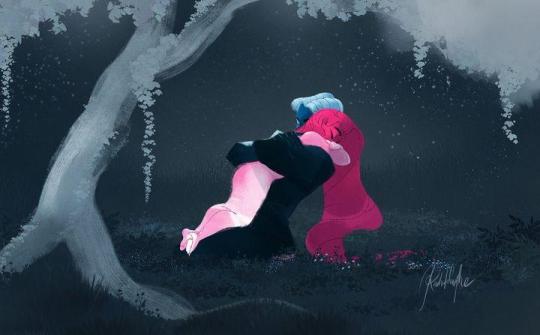
It's pretty rough, ngl. Not even necessarily because of the art itself, but because it's not a panel she should have ever redrawn to begin with.

The whole point of that scene was to showcase Persephone bringing life into the Underworld, a place where only death existed, but in this redraw it completely lacks that messaging, resulting in a scene of Persephone and Hades simply hugging each other in the dark with very dead-looking foliage surrounding them.
On a structural level, the composition has gone from vertical to horizontal, giving us way too much empty space around them which, again, is failed by the background being so dull and lifeless; Persephone's somehow become even smaller; and worst of all (though I'm sure some people will think I'm overreacting) her hair isn't tucked up in Hades' arms anymore, it's just sort of falling perfectly over his shoulder as one solid goop of pink, strangely changing shape as if it's resting on something but there's clearly nothing there.
That said, my opinions should be taken with grains of salt because I also have a lot of personal beef with a redraw like this - that original panel was my phone background for like, 2 years, and the episode it came from is still one of my favorites of all time in spite of all the criticisms I now have of the series, with art that originally inspired me to want to learn how to draw like Rachel.
There's been a lot of evidence over the past year or so to suggest that Rachel has "fallen out of touch" with her own work and these redraws that she's been making lately feel like tangible proof of that. The context in which she created those original panels no longer exists so to try and redraw them fundamentally misses the point of why they were so iconic to begin with.
I can understand that feeling of falling out of touch with your own work, to the point of not even seeing the appeal of it yourself anymore, but that's all the more reason to keep moving forward, not back. The fact that she's still just muddling around with LO stuff despite announcing two more projects and seemingly not making any progress with either the TV show or Rachel Smythe Presents... it really does seem like she's stuck in limbo. The deadlines and contractual obligations aren't there to motivate her anymore, and while that may now have freed her from the burden of creating LO in such a cramped and unhealthy space - now being able to create it simply for herself - I think the years of working on it have definitely taken its toll on her ability to create the way she used to and so we're seeing those growing pains now.
The real bummer about it is that it's being celebrated as "growth" but it's about as much growth as the illustrated environment above - dead and bleak.
#ask me anything#ama#anon ama#anon ask me anything#lore olympus critical#anti lore olympus#lo critical
222 notes
·
View notes
Text
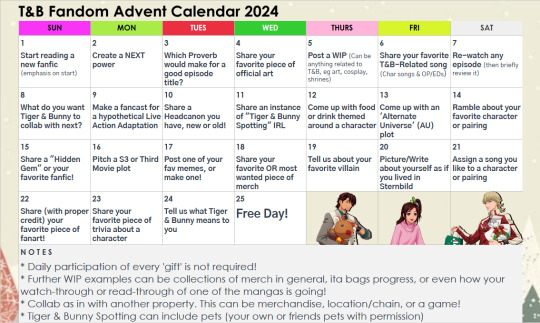
Welcome to the Advent Calendar 2024!
Didn't make it to Secret Santa due to lack of time? Don't worry! This year, there will be a complementary event called "Advent Calendar" where you can spread your love for the series without sticking to a schedule!
What is an Advent Calendar? Traditionally, an advent calendar is a special type of calendar that counts down the days until Christmas Day, starting from 1st December.
How do I participate? Simply create a Tumblr or Twitter post with the activity indicated for the day and use the tag #TnBAdvent24, and we'll reblog/retweet it!
Do I have to participate every day? No! The point of this side event is for you to spread your love for the series without the pressure of a schedule like in the Secret Santa! You can participate any day you want: one, two, ten, all of them! Your choice!
Can I participate in the side event if I joined the Secret Santa? Yes! This event is entirely free, so that you can participate at your leisure.
If I missed an activity from a previous day, can I still post it? Yes! Just use the tag we'll reblog/retweet it! We just suggest that you don't use an activity scheduled for a later date and wait until the indicated day to publish it.
Happy creating!
See below the cut for the text version of the activities indicated
1st - Start reading a Fanfic (emphasis on start, no need to finish it the same day)
2nd - Create a NEXT power
3rd - Which Proverb would make for a good episode title?
4th - Share your favorite piece of official art
5th - Post a WIP (This can be any work-in-progress related to T&B, a merch collection, a shrine, a cosplay, art, MMD video, ita bag, progress of your read-through of the manga, that stuff!)
6th - Share your Favorite Tiger & Bunny-related song (This means any song made for Tiger & Bunny specifically, including character songs and music used in the episodes and credits)
7th - Re-watch any episode of Tiger & Bunny (and then feel free to post a review of it)
8th - What do you want Tiger & Bunny to collab with next? (Collaboration in this context is a collab with another property, such as a company like Sanrio, a store chain like 7-11, restaurant/fast food chains, games, and similar)
9th - Make a fancast for a hypothetical Live Action Adaptation of Tiger & Bunny
10th - Share a headcanon - new or old - that you have
11th - Share an instance of "Tiger & Bunny Spotting" you've seen IRL (T&B Spotting is seeing things like their colours or associated animals-theming in unexpected places. Pets can count for this; If it's not your pet, ask for permission before posting.)
12th - Come up with a food or drink themed around a character. Actually making it is entirely optional!
13th - Come up with an 'Alternate Universe' (AU) plot. You don't have to write anything beyond a plot synopsis or roles.
14th - Ramble about your favorite character or pairing!
15th - Share either a "hidden Gem" fic, or your favourite fanfic! Maybe it's both?
16th - Pitch a Season 3 or Third Movie plot
17th - Post a meme you really like, or make a meme from scratch
18th - Share your favorite OR your most wanted piece of Tiger & Bunny Merchandise
19th - Tell us about your favorite Villain
20th - Picture/Write about yourself as if you lived in Sternbild
21st - Assign a song you like to a character or a pairing
22nd - Share your favorite piece of fanart! Make sure to credit the artist, or repost the art directly through reblog or retweet or similar features.
23rd - Share your favorite piece of trivia about any Tiger & Bunny character
24th - Tell us what Tiger & Bunny means to you
25th - Free Day! Happy Holidays!
144 notes
·
View notes
Text
As a Art History and Heritage researcher, I have to say “Nosferatu” (2024) geniality cannot be underestimated. This is an absolute historic triumph. Robert Eggers recreated the early 19th century setting, way of thinking and behaving, so masterfully, he actually convinced the general audience into believing the Victorian characters are the “good guys” here, and the Eastern European Pagan shaman-priest is the villain of the story, and that his protagonist Ellen is a passive victim at his hands. And now many are starting to realize that’s not the case and are throwing a fit or making weird mental gymnastics to validate their incorrect interpretations.
This isn’t surprising because this tale has years on the making, and it’s an entirely new story under a familiar make-up. Academics and researchers helped shape this story (History and Romanian folklore; Eggers is an occult scholar himself but he only talked about it publicly once); Academic thesis were used to create the script and the world building (“Dracula” literacy analysis; Şolomonari connection to Zalmoxis worship); a dead language was reconstructed for this (fictional but very well-researched alongside linguistics specialized on Balkan extinct languages); two different types of English are spoken (late 16th century and 19th century). The historical accuracy of everything is on point: Romanian Folklore, Victorian sexuality views, Victorian medicine, demonization of Pagan beliefs by Christianity, 19th century racist theories; the threat of female sexuality as a contagious disease (Ellen), etc. If this wasn’t horror I would even recommend this film as a study tool to understand the early 19th century.
The comprehension of these references and themes are way out of your league. Many of these are academic-level knowledge; others should be general knowledge (Victorian era as sexually repressed) but apparently aren’t(?) Either way, the entire “discourse” around this film comes from the general audience lack of historical knowledge and ignorance about these themes and references. I’m an academic myself, and I had to breakdown the entire story to see what this is actually about. Some of you watched this film once and already think you know? When you can’t even interpret one scene from this film correctly, and think Orlok appeared to Ellen when she was a little kid or that Ellen’s father abused her?? The prologue and her scene with Von Franz contradicts both these “interpretations”. Most of you don’t even realize it was Ellen who cursed Orlok to be a strigoi, to begin with (or probably don’t know what a “strigoi” is).
The cast and crew already explained what this film is about in interviews, but there appears to be a weird rejection of everything the creators of this story have to say. But Robert Eggers probably isn’t concerned because he didn’t make this film for you. The way modern audiences digest Art is extremely bizarre to me. This is not how interpretation of Art works, and I tell you this as someone who interprets Art in its historical context for a living. This is my job. And this is a director obsessed with historical accuracy and with a strict artistic view. There are no “multiple opposite interpretations” here. Because he’s using specific academic thesis to create his story. On a personal level you can see whatever you want to see, but if your intention is to understand this story know you are incorrect. And the majority of the “breakdowns” and “interpretations” out there are incorrect and the only world I can use to describe them is “bullshit”. Because these content creators and influencers have no idea of what they are talking about. But the Internet gave them the illusion they do, and they are very proud in displaying their ignorance to the world. Or those who are going around making jokes about “wanting to bounce on Orlok crazy style”. Your anti-intellectualism gives me second-hand embarrassment. This is the peak definition of functional illiteracy, and what’s worse is that the folks who want to know will come across this content and think “yeah, that’s what’s this film is about”.
This entire story a huge middle finger to Christian Victorian society. This a celebration and vengeance of Paganism on Christian civilization, embodied in both Orlok and Ellen characters. Robert Eggers called Ellen the only heroic character of his story; and Ellen and Orlok share the same spirit, the same nature (one Ellen rejects until she embraces it, at the end). They are the true heroes here. The Pagan priestess and the Pagan priest-shaman bringing death and plague upon the Christian civilization that demonized them using their Sex Magick, and end it with Sex Magick too, to give birth to the New Age of Aquarius (which was already the occult meaning of the 1922 “Nosferatu” ending, Eggers included the divine feminine instead of the “virgin sacrifice”). That’s why Eggers describes his ending as a “sacred marriage” between Ellen and Orlok: their sexual encounters are ritualistic, and always have been, and it’s Ellen sexual energy that conjures Orlok, every time: she’s the one who calls out to him, always. She has full agency over their connection (and Herr Knock ritual scene should tell you this; Ellen ending their connection when she met Thomas, and sending the maiden token to reconnect).
Everything that happens in this story is according to Ellen’s will. She has Orlok where she wants him to be; and, yes, she plays both Thomas and Orlok, and weaponizes them against each other (“Wuthering Heights” inspiration, hello?). Because she’s a dark character (like every Gothic horror protagonist), and her innocence and naivety are a front she puts on for Victorian society, her true self is only shown in some occasions because this story gives you several POVs. And that’s why Lily-Rose Depp tells us Ellen is “not a victim at all” because “she’s the one calling the shots the entire time”. She’s like Catherine; she wants to fuck around with Heathcliff/Orlok, while being married to the respectable Edgar/Thomas. But here it’s Orlok that’s not having any of it. I would even say the only victimized character here is Thomas himself, who gets caught up in the middle of something he doesn’t know nor understands and gets his entire life wrecked as a result (like Edgar Linton).
This whole story is about Ellen liberating herself from Victorian society, taking ownership of her own sexuality (one that according to Victorian era belongs to her husband) and embracing her nature, as she fully accepts Orlok at the end. She’s as evil and as good as he is. It’s not that hard to understand.
#that’s it that the rant#Nosferatu 2024#Robert Eggers#Ellen Hutter 2024#count Orlok 2024#Thomas Hutter 2024#friedrich harding#anna harding#professor Von Franz#Von Franz#dr sievers#Herr knock#Victorian era
104 notes
·
View notes
Text
Tensei Ringo and Choji
(I apologize for the lack of quality for some of the panels, I hate tumblr image limit)
A few years ago, Nii Satoru had drawn a series of WBK characters parodying certain J-pop/Vocaloid songs. Nearly all of these arts containing the songs had lyrics that directly related/fit the character drawn, such as Endo sitting like Kenshi Yonezu in Shinigami, Sakura running in a similar fashion shown in the Mahi music video by yama, and Tsubaki drawn as the girl in Gira Gira sung by Ado.
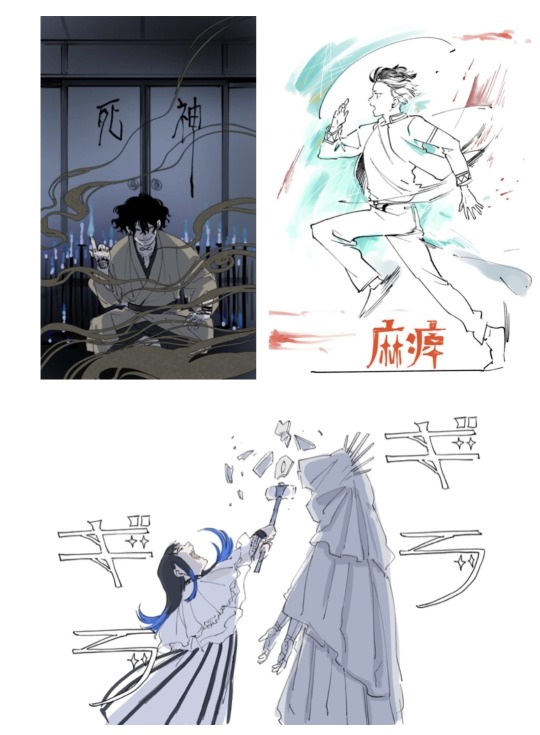
However, there is one particular art that stands out to me: Choji parodying Tensei Ringo (Reincarnation Apple) by PinnochioP.

For context, Tensei Ringo tells the story of a person (the singer) being generally unsatisfied with their life and themself as a person. They buy a magical apple which lets them reincarnate and start a brand new life every time they bite into it. Though they manage to accomplish great things in during their multiple lives, they all eventually end badly. The singer then realizes that no matter reality they’re in, their reality will always turn sour. The singer throws the apple in the trash can in the end, choosing to live with their normal reality instead.
If you would like to know more about Reincarnation Apple’s plot, I recommend checking out the Vocaloid Lyrics Wiki article for the song, from which I’ve taken the translated lyrics from.
But isn’t the song about isekai’ing and being unsatisfied with every reality you’re in? How does this relate to Choji in any way?
As mentioned in the prior examples, Nii-sensei had deliberately chosen specific songs with lyrics that fit certain characters. The same applies to Choji, though Tensei Ringo’s straightforward lyrics take a different meaning altogether if you apply the context of Choji’s story to them.
For the analysis part of this post, I’ve only included lyrics that relate to Choji/Shishitoren rather than the full song, due to it’s indirect nature when attributed to their story. Tensei Ringo is one of my favorite PinoP songs, so without further ado, here’s my own interpretation of it!
Lyrics
I hate my ordinary self, I despise my colorless life
This alludes to Choji’s mentality when he first became the leader of Shishitoren. Unsure of how to proceed now that he’s finally reached his goal, he finds himself confused. He then started to blame his teammates, rather than himself for his issues.
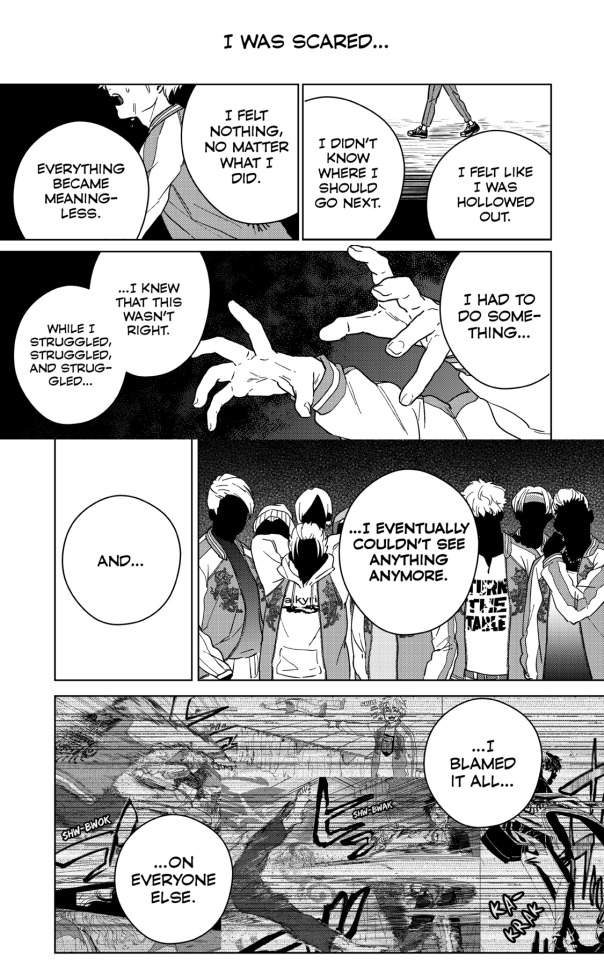
‘Colorless’ can also refer to how Choji was constantly bored throughout the Shishitoren arc, complaining about not having fun.
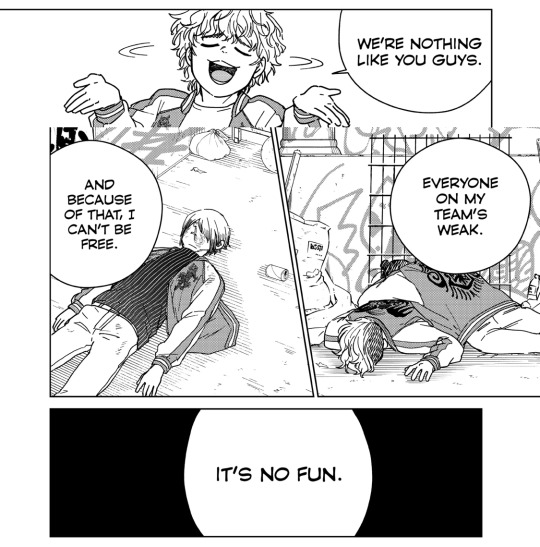
I took a mouthful of a suspicious apple that I bought from a shady dealer // All the shrewd wannabes are doing it // I can be reborn as someone meaningful with this Reincarnation Apple
Choji had always wanted to become the top of Shishitoren, though with the misconception of ‘becoming free’. The reincarnation aspect of Tensei Ringo now becomes a metaphor for leadership/strength, rather than ideal escapism.
This line can also refer to Umemiya’s own leadership, and how Choji used to envy him as the top of Furin.
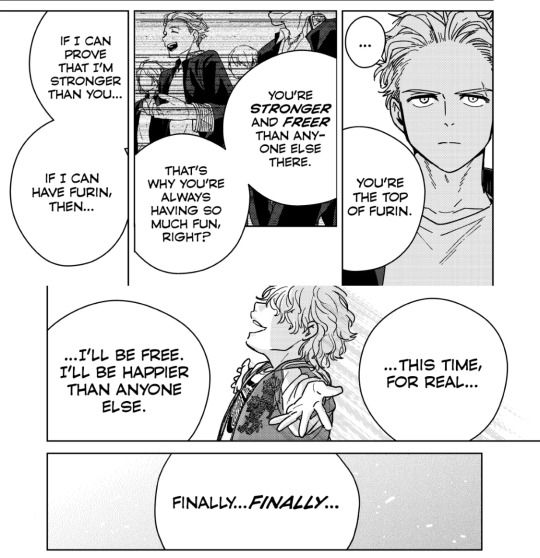
I became an artist, from the whole world I was praised // I was special, everyone else ordinary, in my talent I was befuddled and amazed
Choji has always been admired when in Shishitoren, whether it be for his bright personality or his sheer strength. He was genuinely loved by everyone…

But I lacked the gift to love, and my beloved others abandoned me
This line doesn’t really fit Choji’s story as the opposite occurred during SSTR arc, but I like to interpret this as Choji not realizing that he’s always been free when he’s with his teammates (lacked the gift to love), and how the members of Shishitoren had been kicked out of the team if they were perceived as weak (maybe Choji percieving them as ‘abandoning’ Shishitoren’s priniciples/being strong).


I became an inventor, I created the invention of the century
‘Invention’ could possibly refer to Choji’s wanting to be as free as possible, so he decided to become the leader of Shishitoren, as well as Choji wanting everyone to become as strong as him.

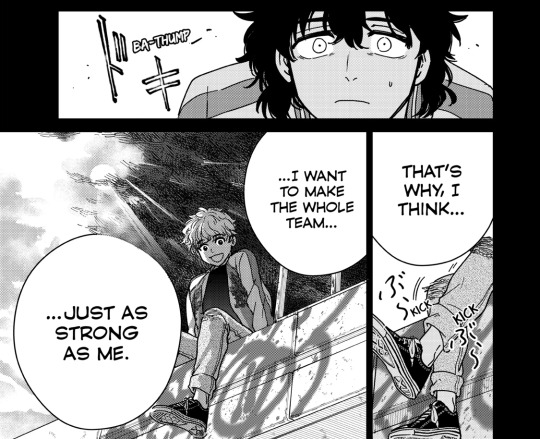
“Please bring peace to the world”, I prayed truly and sincerely
Much like the singer in original song, Choji thinks that his idea will help change Shishitoren for the better.

But my invention was weaponized, a cruel rain of blood it created
Spoiler alert: It didn’t, thanks to Togame. Since he had enabled Choji instead of challenging his faulty ideals head on (my invention was weaponized), Togame had effectively ruined Shishitoren by discarding those who were ‘weak’ (a cruel rain [given it was actually raining when Jo made his promise] of blood it created).

Strategies to win in life, surefire guide to feel elate
Pretty much summarizes Choji’s initial mentality as a leader: being the top made you the freest and is fun—though Choji wasn’t able to experience either of those things.

How imprudent, did your “selfhood” evaporate?
This is literally Umemiya’s sentiment towards Choji:
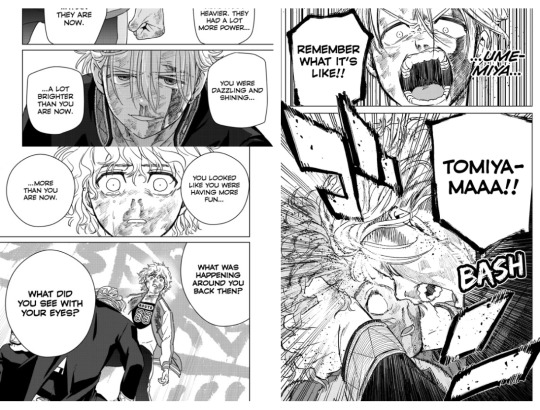
Dancing on a mountain of corpses
This lyric reminds me of the chapter art below. ‘A mountain of corpses’ references the amount of people kicked out of Shishitoren for being too weak, hence Choji sitting the pile of jackets. The ‘dancing’ part could show how Choji was rather careless about how he handled his team.

Love me, love me, no~
This particular line is repeated throughout the song’s choruses; and with it, a picture of a sun is also shown in the music video. Togame calls Choji the sun. I think these two images explain themselves.

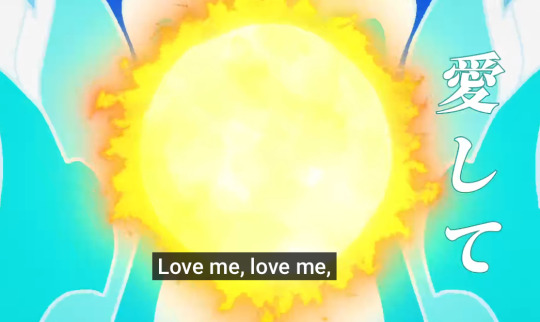
The same characterless stories are sparkling
This could refer to Choji’s perspective of the fights in the Orion. Though they had moved Furin students (and the audience in that extent), Choji never fully understood the nuance of each fight, only admiring the skills of the fighters themselves. He even sleeps through Suo and Kanuma’s fight.

Reincarnation, overkill at the end of endless reincarnations
‘Overkill’ can exemplify the state of Shishitoren during Choji’s initial leadership.

I became a savior, unconditional love I gave to all // Worshiped and respected by the people, young and old I would enthrall
Connects back to Choji being loved.

But I was too innocent, evil deceived me and to the bare bones they ate
Could either allude to how naïve Choji was before he became the top (evil being the need to be free), or Togame willingly enabling Choji.
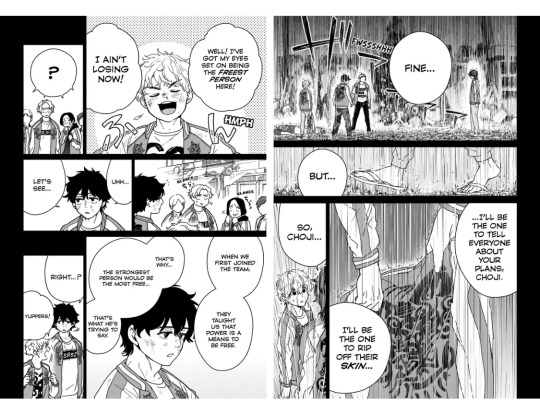
I became a revolutionary, I despised the lip service and deceit // I questioned and fought in a world where the honest always faced defeat
This is my personal interpretation, but I believe that this line relates more to Togame’s true wish to stop Choji rather than Choji himself.

But I was consumed by my power and even peace I cremated
Self explanatory.

I don't have a great cause, just change and reset
Refers to Choji not having a proper goal to achieve once he became the top as well.
A slave to pleasure, the ghost of a highbrow smartass // Even in another world, reality was just as lame
Connects back to Choji wanting to be free, and constantly feeling bored after he became Shishitoren’s leader.
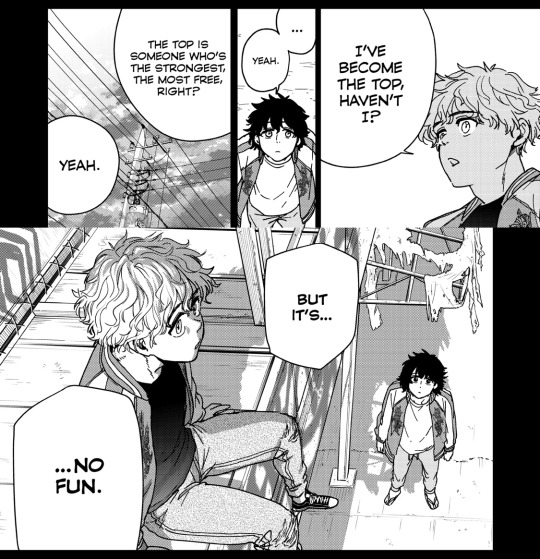
Again and again, reborn and reborn // Historyless and uneducated? I'm sorry
Shows Choji’s ignorance (and him apologizing to Togame after his fight w/ Ume)

I became an adventurer, I set out in search of an ideal // Everyone marveled at me as I took on the most challenging ordeal
Yeah.

But my ideals went to the extreme, innocent lives I sacrificed // Oh, oh, not again? What destination will suffice?
YEAH.

Oh, my reincarnation is over, I'm back to my ordinary self // I'm sad but I breathe a sigh of relief, where should I go from here // Everyone quits once they’re sober, a sense of self, we become mindful
This is quite literally Choji after Shishitoren arc lol
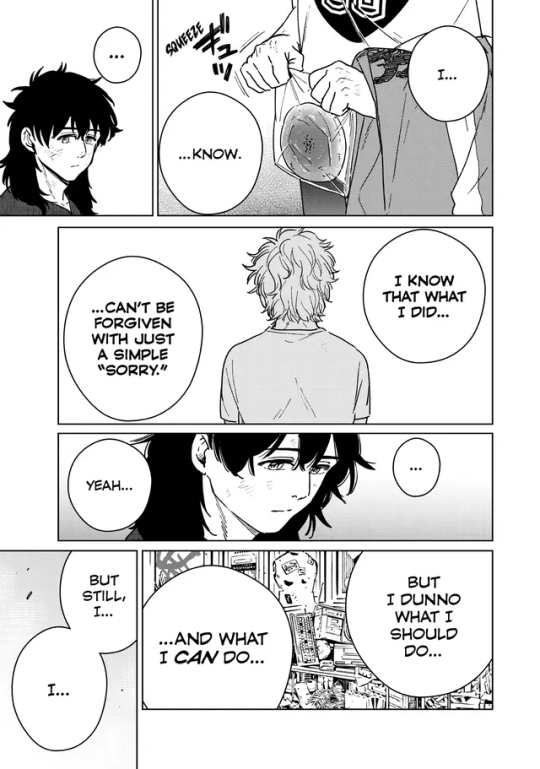
Straight into the trash, the Reincarnation Apple
Relates to how Choji finally realizes the error of his ways post-Shishitoren.
Additional Thing
What’s funny is that in the other official parody arts, the characters seem to be doing the things depicted in their respective MVs. Furin Trio does the silly little dance shown in Solar System Disco by NayutalieN, and even Suo sits just like Kaito in Shanti by wotaku.
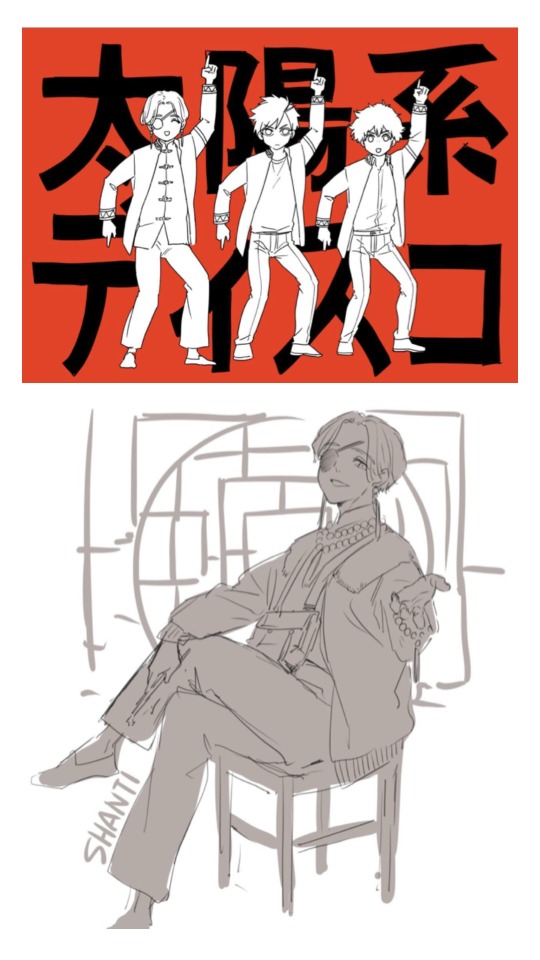
But in Choji’s art (pls scroll back up to see it again), he’s holding the apple, as compared the girl in the thumbnail of Tensei Ringo. It’s nowhere near his mouth—and it’s probably because unlike in Reincarnation Apple, Choji didn’t overindulge himself (bite into the apple over and over again when he felt unsatisfied) in being the freest or use his power to do worse things, since he realized his wrongdoings in the end.

56 notes
·
View notes
Note
can you spare tumblr and save your incest brother fics for ao3 or something? why all of you doing incest suddenly it’s super cringe and on top of that it was SA
Spare Tumblr? Tumblr, the freakshow site? Have you seen some of the shit on here, my friend? Nah, but I will spare my followers the rest of my rambling.
I tagged my post saxloch and saxon x lochlan. I warned for nsfw and incest so anyone who had those tags/keywords blocked wouldn’t see it. I very deliberately did not include any broader TWL tags, nor did i tag the characters’ names as an extra measure of sensitivity, and my bio explains I am pro ship. I did my job. Your job is to curate your online experience. Tumblr makes it very easy to block tags and keywords you don’t want to see, and tons of folks have been posting about these bros for months, I'm no pioneer, so I really wonder how someone could run across something they hate unless they’re trolling those tags or failed to use the tools available.
“All of you doing incest suddenly” uh the Bible did it first, so take it up with that god. Or at least take it up with Mike White, the queer man who made it canon. Second of all, incest ships have been around as long as I’ve been in fandom (20+ yrs) and beyond I’m sure. Back then it was Starcest. Wincest popularized it, then there was GoT, which didn’t bother anyone because it was het and I guess because there were dragons or something. Feature films have romanticized incest. Nothing sudden about it, either way. As for its increase in popularity, that’s partly because fandom as a whole has increased in popularity, and more pointedly, because people are realizing (this just in!) fiction is not reality and it’s okay and normal and even healthy to explore taboo/toxic/problematic things in a fictional context because it isn’t real. People are tired of policing and censoring their imaginations and fantasies. Our thoughts have no moral standing. Real-world choices are all that matter. Actions should be regulated; imagination and art should not.
“Super cringe” is probably the most subjective description in the world. Mpreg is cringe to me, I find violence and noncon nauseating. You know what I do? Shut up, keep scrolling, and let people enjoy what they enjoy. We’re all just playing with dolls here.
As for the SA, I find it interesting you call that out but not the grooming that led to it? You are welcome to interpret what happened as SA, but given the deliberate ambiguity of the narrative, to claim it was definitively one thing or another reveals a lack of critical thought. Mike White is known for (and proud of) creating subversive queer sexual content. He is a brilliant storyteller who developed a storyline intended to confuse, distort, spark debate, and challenge our perceptions of sexuality, abuse, and the human psyche. This storyline hinges on its ambiguity. Each line of dialogue, each editing choice, each frame was meant to leave us wondering. As an audience, we were intentionally not given adequate information to make irrefutable claims about what happened. You cannot analyze this story in black and white, and in trying to do so, you've misread the entire creative intent. We have no idea what transpired between the kiss and the infamous handjob, nor do we know what happened after. That was a total of maybe, what, 60 seconds of severely intoxicated flashback content? And the incredible vagueness of the brothers' final conversation afterwards? That was all intentional, man. We were intentionally deprived of further clarifying footage in order for the narrative to uphold ambiguity. For all we know, they could've engaged in other sexual activity before and after the handjob heard 'round the world. The point is we don't know, so no one can definitively claim it was or wasn't SA.
But none of that matters because it's fiction, and ships can be as fucked as we like. :)
Please be sure to block me because I'm not done "doing incest," thanks!
36 notes
·
View notes
Text
Understanding the Romantic Narrative Arcs in Final Fantasy VII

There has been no shortage of discourse surrounding the “Love Triangle Debate”, (a fan-constructed term, I must inform you) of FFVII for a very long time. Most recently, with the release of FFVII Rebirth, this discourse has intensified and led to a wide spectrum of fan conclusions that range from grounded in narrative sense to completely baseless or delusional. Some takes are attached to contemporary relationship issues, personal experience, comparisons to other media or works of fiction, social constructs or societal issues, personal preference, or a lack of full context.
While any piece of media or fiction is subject to some level of interpretation (this is the very nature of humans consuming works of art), most works are created with intentional narrative direction. In fact, many works are formulaic, especially in genres such as fantasy, romance, mystery, etc. While of course there are always exceptions and deviations, as a writer and former English literature teacher I can say that most stories follow a general narrative structure or arc that makes them digestible and satisfying to readers/audiences. Such arcs impact the main, external, internal, and subplots of a story, as well as individual character arcs and character relationship arcs.
Final Fantasy is no different. While there are other cultural influences as FFs are Japanese stories, my experience with the series is the writing generally follows most storytelling conventions that can be found in all forms of archetypal writing, cross-culturally and generationally. FFVII is often accused of being ambiguous or open-ended in many aspects of its story. I tend to disagree with this idea and think that its storytelling is subversive rather than ambiguous, meaning that it requires players to work harder and use more critical thinking in order to reach the author’s intended conclusions. It also relies on false or misleading narratives for a good part of the story (such as red herrings, illusions, or unreliable narrators) as storytelling devices that help the truth in the story unfold in later parts of the narrative arc(s). Like any piece of media using these storytelling methods, this means that there will be controversy or debate as audiences contend with the author’s messages or intentions. However, that does not mean that the intentions are not there and that there is not an intentional outcome on the part of the writers.
Personally, I believe that FFVII has a very clear narrative structure for all of its main plot, sub plots, and character arcs, but that its approach is challenging to many players who have to wrestle with the story as it unfolds to understand it. It is not spoon-fed, and some revelations may betray player attachments that were originally formed. However, in my view, this is what makes FFVII such an exceptional story when compared to many others. That being said, the lack (or refusal) of understanding of FFVII’s narrative arcs has led to discourse that unfortunately mischaracterizes many of the characters and pushes inappropriate perspectives onto the storytelling, mostly surrounding the romantic arcs of the main characters and the so-called “LTD” (the fan construction, remember?). I strongly believe that the best way to understand any story is to follow the narrative arcs in order to arrive at the author’s intended conclusions.
I’m going to attempt to do that for the romantic subplots in FFVII in hopes of bringing some clarity to this issue. This analysis is based on a standard Three-Act Romance narrative writing structure (which aligns with the Hero's Journey structure), as well common romantic archetypes and tropes, both for characters and plot, but applied to the specific context of the story, world, and characters of FFVII. Please note that this is my personal analysis and it is by no means perfect, nor am I saying this is the bible of how FFVII has been written. I just hope it gives some insight into why some storytelling interpretations of FFVII should make more sense than… others. This analysis will draw from bits of the entire compilation, but the primary focus of the structure will be looking at FF7R with the OG as a baseline.
This is a long thread, so please see the outline for discussion below.
Romantic Structure/Trope Analysis
Cloud/Tifa: The Slow Burn/Childhood Friends to Lovers Romance
Aerith/Cloud: The Unrequited Love/Not Meant to Be Romance
Zack/Aerith: The Long Lost Love Romance
Final Thoughts: The "Love Triangle" is a Narrative Illusion
Cloud/Tifa: The Slow Burn/Childhood Friends to Lovers Romance

Act 1: The Beginning
The Hook (Childhood Connection Revealed)
Romance Structure: Introduction / Setup
Purpose: Establish the protagonists in their everyday lives, showing what emotional or psychological issues are holding them back from love. Readers should get a sense of their internal conflicts and motivations, along with the external situations that will challenge them later.
Childhood Friends Layer: Introduce the deep connection between the two characters, showing them as lifelong friends with an established bond. There could be hints of one or both characters secretly harboring feelings for the other, but they haven't acted on it due to fear of losing the friendship.
Example: Cloud and Tifa are childhood friends with a complicated history. Although they were close when they were little, they drifted apart but secretly longed for one another. They shared a romantic promise and then separated for seven years. At the beginning of FFVII, they are reunited, but both characters are contending with serious internal and external conflicts - Cloud’s identity crisis and the Shinra Company’s greed and abuse of the planet.
The Inciting Incident / Call to Adventure / Meet-Cute
Romance Structure: Inciting Incident / The Meet-Cute
Purpose: The main characters meet or are pushed together by external circumstances. This encounter introduces the romantic conflict—whether it’s instant attraction or tension between them.
Childhood Friends Layer: Since they’ve already known each other for years, the “meet-cute” here is more about seeing each other in a new light. Maybe one of them returns to town after time away, or an external event shifts their dynamic, making one or both start to view the other differently.
Example: Cloud and Tifa reunite in Midgar and Tifa recruits Cloud to work for AVALANCHE. She does this primarily to keep him close so she can keep an eye on him as she is worried about him and his mental state. During this time, we see an instant chemistry between Cloud and Tifa as they reconnect after years apart. When conflicts are introduced, we see the strain that it puts on them, but we also see how there’s a lingering desire for closeness, whether it be in their discussion/memory of the promise, their mutual flirting, their skinship, etc.

First Plot Point / Refusal of the Call
Romance Structure: Rejection of the Relationship
Purpose: The characters resist the idea of a romantic relationship, often due to internal or external obstacles. There’s a clear push-pull dynamic as they fight their growing attraction, often rejecting the possibility of being together.
Childhood Friends Layer: The hesitation here comes from their shared history. Both characters are afraid to risk their close friendship for something as uncertain as a romance. This dynamic creates tension as they begin to realize how much they depend on each other emotionally.
Example: This isn’t directly addressed, but the narrative deflects from intentional romantic confrontations at this point because of Cloud’s identity crisis and the pressing issues of the external conflict. Neither character is outwardly pursuing a relationship, but they don’t exactly deny their desire for closeness. We consistently see the push/pull between Cloud and Tifa throughout the early part of their arc. It's also further complicated when Sephiroth starts to sabotage their relationship.

Act 2: The Middle
First Pinch Point / Acceptance of the Quest
Romance Structure: Giving the Relationship a Chance
Purpose: External circumstances push them together, forcing them to interact and face their growing connection. Even if they resist the idea of love, the bond between them deepens as they spend more time together.
Childhood Friends Layer: Their shared history becomes an advantage and a source of conflict. The deeper they dive into new romantic feelings, the more they rely on the comfort of their friendship, but they’re also terrified of crossing the line and ruining everything.
Example: Cloud and Tifa work together both with AVALANCHE and the party at large to combat the threats present in the external conflict. Additionally, they share deep trauma from the Nibelheim Incident that brings them closer together as sources of comfort. They become one another’s rocks, and though they still do not move toward any explicit romantic confirmation, it is clear from their behavior that they both hold deep feelings for each other and care for each other greatly. Cloud in particular holds on to his promise to Tifa, making it a cornerstone of his strength moving forward.

Midpoint Crisis / Trials and Temptations
Romance Structure: Midpoint / I-Need-You-But-Can’t-Have-You
Purpose: This is a major turning point where the characters either experience a "false high" (where they feel like things are going well but something still isn’t quite right) or a "false low" (where they feel like things are falling apart). There’s often a pivotal moment of intimacy that deepens their bond but also introduces new fears.
Childhood Friends Layer: The fear of losing the friendship intensifies. They might experience their first kiss or confession of deeper feelings, but the risk of ruining their long-established bond makes the situation more fraught with anxiety.
Example: This particular point in the arc gets a little tricky for Cloud and Tifa because of Cloud’s identity crisis and Tifa’s reticence around their mismatched issues. However, Rebirth has made it clear that before the end of disc 1, Cloud and Tifa are aware of their feelings for each other and that the narrative is still in the way of it. This arc intersects events that transpire from Kalm to Gongaga, and we see the build-up of tension due to the internal conflict between Cloud and Sephiroth.

Second Pinch Point / The Road Back
Romance Structure: Pulling Back Together
Purpose: The characters are drawn back together by external events, but their internal fears and conflicts still loom large. The romance starts to deepen, but both are still fighting their feelings in some way.
Childhood Friends Layer: They try to go back to being "just friends," but it’s clear that things have changed between them. The emotional and romantic tension keeps building, and they can’t ignore how much they need each other.
Example: We see this dynamic between Cloud and Tifa continue to build throughout disc 1, particularly in Rebirth. We are consistently reminded of the tension between them and the importance of their relationship, regardless of romantic intent. Gongaga and Nibelheim are great examples of this.
Second Plot Point / The Fall
Romance Structure: The Fall
Purpose: The characters are now falling in love, even if they haven’t fully admitted it to each other. There’s often a deeper moment of intimacy—physical or emotional—that makes them realize just how much they mean to each other.
Childhood Friends Layer: One or both characters realize they’ve fallen hard for their best friend, but they are still careful or hold back from telling the other, afraid it might ruin everything. Nonetheless, they give in to their feelings in some capacity, which marks a turning point.
Example: The Gold Saucer date would be the best parallel for this point in the arc for Cloud and Tifa. In the OG Tifa almost confesses to a very interested Cloud, in Rebirth, they confirm feelings and kiss. Either way, it’s clearly meant to signal at this point, the fall has happened.

Act 3: The End
The Crisis / Dark Moment
Romance Structure: Dark Moment / The Break-Up
Purpose: This is the point where everything falls apart. The characters break up or distance themselves, either because of internal or external forces.
Childhood Friends Layer: The weight of their shared history makes this moment even more devastating. The fear of losing the friendship forever becomes real.
Example: For Cloud and Tifa, this moment is really hinged on Cloud’s mental breakdown. After the Gold Saucer Date, Cloud’s mental state progressively worsens due to events that occur within both the internal and external conflicts, and his bond with Tifa is severed completely at the Northern Crater. Cloud and Tifa are separated when Cloud falls into the Lifestream.

The Sacrifice / The Crisis Resolution
Romance Structure: The Sacrifice
Purpose: One or both characters must confront their fears and make a choice. This moment often involves a grand gesture or a realization that love is worth the risk.
Childhood Friends Layer: The realization comes that their friendship has always been the foundation of something more. They understand that risking the friendship for love is not only worth it but that the friendship can only deepen through their romantic connection.
Example: This point comes in Mideel and the Lifestream Scene. Tifa reaches her own realization about her relationship with Cloud and how her reticence has impacted things, and her conviction to save him and be with him is both profound and clearly romantic. Inside the Lifestream, Tifa helps Cloud to find himself, and many revelations about his true feelings for her are brought to light. Of course, we have not reached this point of the story in FF7R, so it will be intriguing to see how it unfolds, given all of the additional context the remake series and ToTP have provided.

The Climax / Declaration
Romance Structure: Declaration
Purpose: The characters finally confess their love for each other, making the leap from friends to lovers. This is the emotional high point where the relationship is solidified.
Childhood Friends Layer: The confession of love is tied to their long history, as they realize that their deep emotional connection as friends is the foundation for a strong romantic relationship.
Example: This moment for Cloud and Tifa is the Highwind Scene in the OG, where they confirm, without words, that their feelings match. Once again, we will see how this event unfolds in Part 3 with all the new and deepened context of Cloud and Tifa’s relationship in 7R.

The Resolution / Denouement
Romance Structure: Denouement / HEA
Purpose: The characters are together and happy, giving the reader a sense of closure.
Childhood Friends Layer: The resolution emphasizes how their strong friendship has transitioned seamlessly into a romantic relationship, giving the sense that they’ll continue to support each other as both friends and lovers.
Example: In the OG, this is seen in the FMV of the game where Cloud and Tifa are together, leading to the resolution of the entire story as Holy and the Lifestream are released. While this scene isn’t particularly direct, it’s enough to show that Cloud and Tifa are together, which leads to ACC where they live and raise a family together. This entire ending segment will likely be greatly expanded in FF7R, and so it'll be interesting to see how these moments are handled, given all of the new context.
Aerith/Cloud: Unrequited Love/Not Meant to Be Arc

Act 1: The Beginning
The Hook (Unrequited Feelings Introduced)
Romance Structure: Introduction / Setup
Purpose: Introduce the protagonist, who falls for the other character. Set up their emotional and psychological conflict, showing how these unrequited feelings shape their interactions with the other character.
Unrequited Love Layer: The character’s love is clearly unreturned, but they hold on to hope. There is a mix of admiration, longing, and pain as they watch the love interest live their life without ever seeing them as a romantic partner.
Example: Aerith’s feelings for Cloud, who she meets first on the streets of Midgar and later inside her church, are inspired by her long-lost love, Zack, whom he reminds her of. We don’t know this immediately, but we find out soon enough, and the story, especially 7R, is full of visual and symbolic cues.
The Inciting Incident / Call to Adventure / Meet-Cute
Romance Structure: Inciting Incident / The Meet-Cute
Purpose: The characters are pushed together by external circumstances, giving the protagonist more time with the love interest. The character sees this as an opportunity to grow closer, but the other character remains unaware or indifferent to their romantic feelings.
Unrequited Love Layer: The character is thrilled to spend more time with the other character and hopes this will bring them closer. However, the love interest still sees the relationship as platonic, creating tension.
Example: While their interaction on Loveless Street is the fated moment for Cloud and Aerith, the meet-cute is their meeting in the church. This is the inciting incident that not only truly triggers Aerith’s latent Zack-longing, but also begins Cloud and Aerith’s friendship as they work together for a common cause. Aerith flirts with Cloud quite a bit at this point, displaying her interest, but Cloud does not reciprocate in any romantic sense. She also refuses to let him leave and follows him around, essentially solidifying Aerith’s place in the player party and cementing her role as the heroine driving the external conflict. From here on out, we are consistently reminded that Cloud reminds Aerith of Zack, the deeper reason for her interest in him.
First Plot Point / Refusal of the Call
Romance Structure: Rejection of the Relationship
Purpose: The protagonist’s feelings remain unrequited. The other character might express interest in someone else or explicitly state that they don’t see the protagonist in a romantic light. This deepens the emotional conflict for the protagonist, who struggles with unspoken feelings.
Unrequited Love Layer: The protagonist is heartbroken but holds onto hope. They keep pushing their emotions down, unwilling to let go just yet.
Example: Aerith meets Tifa and quickly realizes that she is someone deeply important to Cloud. In Remake, she realizes this even before meeting her when Cloud has a headache and calls out Tifa’s name. Her awareness changes her behavior somewhat, but internally, she still is still conflicted because of her internal conflict over Zack.
Act 2: The Middle
First Pinch Point / Acceptance of the Quest
Romance Structure: Giving the Relationship a Chance
Purpose: External circumstances continue to push the characters together, and the protagonist’s feelings deepen. They begin to cling to small moments, hoping that their love might one day be reciprocated.
Unrequited Love Layer: The protagonist interprets friendly gestures as signs of romantic potential. They invest emotionally in every small interaction, hoping it means more than it does. However, deep down, they start to feel the weight of their unreturned affection.
Example: The journey continues with the party leaving Midgar, and Aerith’s feelings for Cloud grow despite her knowledge of his bond with Tifa as the party travels together. In Rebirth this is further complicated by Aerith’s loss of foresight/memories to the Whispers. We are also constantly reminded of Aerith’s lingering feelings for Zack and her grief and sadness over his loss/disappearance. Throughout the journey, she seeks out opportunities to spend time with Cloud - “dates” even though these moments are not reciprocated romantically. A notable example of this is her date with him on the clock tower in Kalm, where she speaks to him about his relationship with Tifa (hinting at her knowledge of their bond and her jealousy over it) and then her public declaration that they were on a date (in front of Tifa). Cloud's reaction to moments like these continue to inform the audience he does not return romantic affections for Aerith.
Midpoint Crisis / Trials and Temptations
Romance Structure: Midpoint / I-Need-You-But-Can’t-Have-You
Purpose: A major turning point occurs where the protagonist either faces the possibility that their love will never be returned or sees a fleeting moment where they think it might be. The emotional stakes are higher, as the protagonist grapples with whether to continue holding on.
Unrequited Love Layer: The character might attempt to make their feelings known, either explicitly or through subtle gestures, but the love interest doesn’t reciprocate. The character is left feeling exposed and vulnerable, yet still holding on to hope that things might change.
Example: For Cloud and Aerith, this continues to be the nature of their relational development throughout most of disc 1, but their interaction on the water tower in Nibelheim is probably the best example of this. Aerith has to grapple with her jealousy over Cloud and Tifa’s bond, which she has been observing for the entire game. Her acknowledgment of her feelings over it is a major turning point as a character. Additionally, this moment really cements that Cloud views his relationship with Aerith as a cherished friendship, as we see the way that he cares about her angry reaction.

Second Pinch Point / The Road Back
Romance Structure: Pulling Back Together
Purpose: Circumstances force the characters to spend more time together, even though the character is starting to feel the emotional strain of unrequited love. There may be a moment of temporary hope, but it’s tinged with the growing realization that their feelings might never be returned.
Unrequited Love Layer: The character becomes more emotionally drained as they begin to sense that their love will remain one-sided. They might try one last time to be closer to the love interest, but the gap between them is becoming clearer.
Example: This moment could best be viewed through Cloud and Aerith’s Gold Saucer date. There, Aerith not only tries to get closer to Cloud but she opens up emotionally and gives Cloud insight into the root of her feelings, which is Zack. Cloud does not reciprocate any of Aerith’s romantic overtures in this date and rather displays discomfort or awkwardness throughout most of it. However, he does allow her a moment of emotional vulnerability, which he has not been willing to do previously. This is further contextualized by how, In Rebirth, Cloud has remembered Zack by this point (albeit incorrectly). Cloud, who cherishes and cares for Aerith greatly as a friend, is considerate of this connection and offers her comfort for the grief and loss she has just admitted to feeling and seeking consolation in him from. Hence "just until the ride's over"; "I didn't do anything" etc...

Second Plot Point / The Fall
Romance Structure: The Fall
Purpose: The character finally realizes that their love will never be returned. This is an emotionally intense moment where they are forced to confront the truth—they will never be more than a friend or confidant to the love interest.
Unrequited Love Layer: The protagonist may be devastated by the final confirmation that their feelings will never be returned. The emotional weight of unrequited love becomes too much, and they start to realize they need to let go, or come to other realizations about their feelings.
Example: The moment that most closely matches with this point in the arc is the dream stroll through Sector 5. Not only does Aerith accept that Cloud doesn’t return her feelings romantically, but she comes to a realization of her own feelings and questions them. This is clearly a reference to Zack, whose internal conflict has been consistently foreshadowed. Aerith also seems to recognize that she can’t help Cloud with his internal conflict - that is Tifa's role.

Act 3: The End
The Crisis / Dark Moment
Romance Structure: Dark Moment / The Break-Up
Purpose: This is the point of emotional reckoning, where they face the reality of unrequited love and move on in their arc.
Unrequited Love Layer: The character experiences grief over their unreturned feelings. They might decide to pull away from the love interest entirely, or they may try to come to terms with remaining friends while letting go of their romantic hopes and moving on.
Example: For Aerith, this moment is marked by her complete transition to her role in the external conflict. At this point, she has let go of her romantic fancy for Cloud and has committed herself to the bigger picture. It is at this point that she leaves the party, and leaves Cloud in the Sleeping Forest, to fulfill her role as a Cetra.

The Sacrifice / The Crisis Resolution
Romance Structure: The Sacrifice
Purpose: The protagonist sacrifices their unrequited love, realizing they need to move on for the sake of their own emotional well-being or greater purposes. This is a bittersweet moment of acceptance and self-growth, where they let go of the hope that kept them holding on for so long.
Unrequited Love Layer: The protagonist may realize that holding on to unrequited love is only hurting them or preventing them from reaching a greater purpose.
Example: For Aerith, this point in the arc is less about Cloud and more about her role in the external conflict. This is the point in which she travels to the Forgotten City, prays, and ultimately is killed. However, it is bittersweet and tragic for her, ultimately, because she dies with unrequited love from Cloud and without ever getting closure on her true love, Zack.

The Climax / Declaration
Romance Structure: Declaration
Purpose: Instead of a declaration of mutual love, this is the protagonist’s internal declaration of acceptance. They start the process of moving on.
Unrequited Love Layer: The protagonist lets go of the love interest in their heart, realizing that they need to focus on their own future. The love interest is likely unaware of this internal shift, but it’s a powerful moment of growth for the protagonist.
Example: For Aerith, this is perhaps best viewed in her complete transition after death to the larger role she plays as the heroine of the planet from within the Lifestream. Her arc has fully transitioned away from her feelings for Cloud into her greater purpose. In FF7R, we can hope to see how Zack, who has been trying to find her, begins to impact this next phase of her arc.
The Resolution / Denouement
Romance Structure: Denouement / HEA
Purpose: Instead of a traditional happy ending, this is a reflective, bittersweet resolution. The character has grown emotionally. There is a sense of closure, though it may come with lingering heartache.
Unrequited Love Layer: The character has let go of the hope that their love would ever be returned. They are stronger for it and have moved on.
Example: For Aerith and Cloud, this moment is best summed up by their brief Lifestream reunion at the end of the game. It will be intriguing to see how this moment is expanded and provides closure for Cloud and Aerith’s relationship, as well as Zack’s role in both.

Zack/Aerith: Long Lost Love/Tragic Love Arc

This arc is a little more complicated to map out since it is not only incomplete but riddled with mysteries at this point. However, I’m going to do my best to make the connections based on the information we have and where we can theorize things may be going.
Act 1: The Beginning
The Hook
Romance Structure: Introduction / Setup
Purpose: Establish the protagonist’s life after the estrangement, showing how unresolved feelings for their lost lover impact their emotional world. There’s a sense of longing and unfinished business that propels the protagonist’s actions.
Long Lost Lovers Layer: The protagonist is haunted by memories of their estranged lover and driven by a deep desire to find them again. This longing is fueled by unresolved emotional wounds, and the protagonist clings to the hope of a reunion.
Example: In Rebirth, from the beginning, Zack is singularly focused on reuniting with Aerith. After his escape from Nibelheim, even as he carries the wounded Cloud, Zack’s thoughts are consumed by Aerith. His love for her pushes him forward despite the dangerous and confusing circumstances he finds himself in. Zack’s motivation intensifies when he discovers, through a newscast, that Aerith is in danger. This revelation shifts Zack from hopeful longing to immediate action, driving home the urgency of his quest. His decision to prioritize Aerith’s safety over everything else, including Cloud, underscores how central Aerith is to his purpose, raising the stakes for his emotional journey.
The Inciting Incident
Romance Structure: The Call to Adventure
Purpose: The inciting incident transitions the protagonist from passive longing to active pursuit of reunion. Some event or revelation forces the protagonist to act, prompting them to seek out their estranged lover. Often, this is triggered by the discovery that the lover may be in danger.
Long Lost Lovers Layer: The protagonist realizes that simply hoping for a reunion isn’t enough—there’s now a tangible reason for urgency. This event serves as a catalyst for the protagonist to fully commit to the journey of reconnecting with their lover, increasing the stakes as they shift from passive longing to active pursuit.
Example: After mysteriously "surviving" his last stand against Shinra (as seen at the end of Crisis Core), Zack rescues Aerith from Shinra’s grasp in Rebirth. However, instead of a triumphant reunion, the moment is clouded with confusion and tragedy. This rescue scene signals Zack’s deep emotions for Aerith and heightens the sense of foreboding in their relationship arc. The player quickly realizes that the reunion isn’t straightforward and that darker forces are at play, casting a shadow over Zack’s determined rescue.
First Plot Point
Romance Structure: Refusal of the Call / First Obstacle
Purpose: The first major obstacle or refusal of the call introduces the initial challenges the protagonist faces in their pursuit of the lost lover. Despite their determination, external forces or internal doubts surface, complicating the journey.
Long Lost Lovers Layer: The protagonist’s optimism about reuniting with their estranged lover is challenged by harsh realities—whether through physical danger, supernatural elements, or emotional barriers. This moment introduces doubts about whether a reunion is possible, raising tension and uncertainty.
Example: Zack eventually brings a comatose Aerith and Cloud to Elmyra’s house. Zack’s devotion to them is evident as he cares for them despite their unresponsive states, but the world around him behaves in strange ways. The eerie sense of something deeply wrong in Sector 5 hints that Zack’s reality—and Aerith’s fate—are far from certain. He’s not just fighting to reunite with Aerith; he’s battling a reality that is becoming increasingly unstable. The player shares in Zack’s growing sense of anxiety and confusion, setting the tone for the more tragic layers of their arc to come.
First Pinch Point / Acceptance of the Quest
Romance Structure: Giving the Relationship a Chance
Purpose: The protagonist resolves to pursue their lost lover, hoping to rekindle what they once had. However, unresolved issues and emotional scars from the past begin to surface, complicating their journey.
Long Lost Lovers Layer: Time and distance have changed both characters, making reconnection difficult. The focus is on how time has altered both individuals and the lingering emotional weight of their separation.
Example: Zack’s attempt to reunite with Aerith is complicated by the metaphysical separation created by the Lifestream. Aerith remains comatose, as does Cloud, and Zack has to contend with both his own internal conflict as he tries to help them as well as the external conflict of his strange and mysterious circumstances within "Sector 5".

Midpoint Crisis / Trials and Temptations
Romance Structure: Midpoint / I-Need-You-But-Can’t-Have-You
Purpose: The protagonist’s need for their lost lover intensifies, but the relationship is far more complicated than expected. Old wounds and emotional or external barriers resurface, making reunion seem out of reach. Despite their determination, the protagonist begins to doubt whether they can ever restore what they once had.
Long Lost Lovers Layer: Time and emotional distance have changed the dynamics of their relationship. While both may care for each other, the past cannot easily be erased, and their attempts to reconnect are fraught with tension.
Example: External forces such as Sephiroth’s manipulations, and Aerith’s internal conflict over Cloud create an emotional barrier between her and Zack. Aerith, “asleep” in Zack’s world, remains unaware of his presence. As Zack learns from Marlene that Aerith’ "likes" Cloud, more tension and conflict is added. Despite these challenges, Zack remains unwavering in his commitment to reconnect with Aerith, determined to overcome the growing emotional distance.

Second Pinch Point / The Road Back
Romance Structure: Pulling Back Together
Purpose: The protagonist makes another push to reconnect with their lost lover despite significant setbacks. Faced with the reality that time is running out, the protagonist must act decisively to restore the relationship. While emotional connections may deepen, unresolved challenges threaten the outcome, leaving uncertainty in the air.
Long Lost Lovers Layer: Despite growing obstacles, the protagonist remains committed to rekindling the relationship. The emotional and physical distance between the lovers may still seem insurmountable, but the protagonist refuses to give up, holding onto the hope that they can salvage what they once had.
Example: Even as Zack’s hope begins to wane, he remains steadfast in his desire to reunite with Aerith. Zack finds himself pulled in multiple directions, creating additional conflicts. External forces and emotional entanglements continue to complicate their relationship, but Zack’s determination to bridge the emotional gap keeps pushing him forward. This section of Rebirth continues to heavily foreshadow both the truth about Zack as well as the future of Zack and Aerith's relationship, despite the conflicts.

Act 3: The End
The Crisis / Dark Moment
Romance Structure: The Break-Up / Darkest Hour
Purpose: The protagonist faces their darkest moment, where it seems that the reunion will never happen. Emotional scars or external forces tear the lovers apart, and the protagonist believes they’ve lost their final chance to reconnect. The relationship nears failure as the protagonist faces the harsh reality of their situation.
Long Lost Lovers Layer: The conflict grows to the point of no return. Previous mistakes or external conflicts surface, causing the relationship to fall apart, and the protagonist is left devastated, feeling that the reunion may never come.
Example: In Rebirth, this moment comes near the ending of the game when Sephiroth's confluence of worlds plays a role in role in further uprooting Zack's existence in the Lifestream. We also know that this is the time that Aerith dies in the real world, further complicating matters and adding new layers of conflict.

The Sacrifice / The Crisis Resolution
Romance Structure: The Sacrifice
Purpose: The protagonist realizes that to win back their lost lover, they must sacrifice their pride, fear, or ego. This emotional climax reflects their willingness to make a grand gesture or display vulnerability, showing they’ll do whatever it takes for a second chance.
Long Lost Lovers Layer: The protagonist makes a final, heartfelt plea to the estranged lover, acknowledging their mistakes and baring their soul. The lover, moved by the sincerity, must decide whether or not to take the risk of rekindling the relationship.
Example: Although we don’t yet know how this will play out in the Remake series, it’s likely that Part 3 will feature a reunion between Zack and Aerith. The conflicts that have built up—including Aerith’s internal struggle regarding Cloud—will need resolution. Advent Children (ACC) shows Zack and Aerith together in the Lifestream, setting the stage for a reunion in the Remake. The exact nature of this reunion remains speculative, but it’s likely Zack will make a significant sacrifice or grand gesture to resolve the emotional conflicts that have kept them apart.
The Climax / Declaration
Romance Structure: Declaration
Purpose: The estranged lover finally decides to take the risk and give the relationship another chance. After much internal struggle, they admit they’ve never stopped loving the protagonist, and they’re ready to move forward together. This is the emotional peak where both characters commit to each other.
Long Lost Lovers Layer: The reconciliation finally happens. After everything they’ve endured, the estranged lover acknowledges their lingering feelings and agrees to rebuild the relationship. Both characters take a leap of faith, trusting that they can overcome the past and move forward.
Example: Though speculative, if the arc follows the long lost lovers trope, Zack and Aerith will likely experience a heartfelt reunion in Part 3. Their lingering feelings would finally be acknowledged, clearing up Aerith’s complicated feelings for Cloud while reaffirming her bond with Zack. This declaration of love would also tie into the larger narrative arc, offering emotional resolution for both characters and allowing their story to move forward, especially in support of Aerith's role in the external conflict of the Planet.

The Resolution / Denouement
Romance Structure: Denouement / HEA
Purpose: The story concludes with a glimpse of the couple in their newly rekindled relationship. The emotional weight of their past has been lifted, and they are now ready to face the future together. Even if circumstances prevent a traditional “happy ending,” there is emotional closure and a sense of peace.
Long Lost Lovers Layer: After the pain, separation, and emotional struggle, the couple is finally together. The audience is left with a sense that their love will endure this time, offering a bittersweet but satisfying conclusion to their long journey.
Example: In Advent Children (ACC), we see Zack and Aerith reunited in the Lifestream, helping Cloud in his final battle. Their reunion suggests that, while they may no longer live in the physical world, their connection endures beyond death. Though bittersweet, their reunion offers emotional closure. The final installment of the Remake series will likely bring full resolution to Zack and Aerith’s arc, providing a satisfying conclusion, even if there are tragic elements along the way.

Final Thoughts: The Love Triangle is a Narrative Illusion
Cloud and Tifa’s Slow-Burn Childhood Friends to Lovers (Canon)
Cloud and Tifa’s relationship in Final Fantasy VII is a carefully crafted slow burn, rooted in a deep bond that extends back to their childhood in Nibelheim. Their connection is not built on superficial or flimsy romantic interactions but on a shared past and the quiet intimacy that grows from years of unspoken longing but is complicated by trauma.
Cloud and Tifa’s natural chemistry is driven by their subconscious desires and the deep, unspoken feelings they have for one another. For Cloud, his buried emotions instinctively reach out to Tifa, even though he isn’t fully aware of them. The narrative hides these true feelings, but subtle moments of affection and protectiveness reveal that, deep down, Cloud’s heart is already tied to hers, laying the groundwork for their eventual emotional connection.
The game’s emotional climax in the Lifestream, where Tifa helps Cloud piece together his shattered memories, is a pivotal moment in which both characters finally confront the depth of their feelings for each other. Their journey isn’t one of dramatic declarations, but rather a gradual, emotional reconnection that allows deeply held, mutual love and longing to blossom—a love that is grounded in shared history, healing, and mutual understanding and compassion.
This slow-burn romance stands as the true heart of Cloud’s emotional journey, dispelling the illusion of a love triangle and making it clear that Cloud’s deepest emotional ties are with Tifa.

Aerith and Cloud’s Unrequited Love / Not Meant to Be Semi-Canon/One-sided) (Fanon - mutual)
The dynamic between Aerith and Cloud, while often misinterpreted as romantic, is better understood through the lens of unrequited love and fate’s intervention. Aerith’s initial attraction to Cloud is undeniably influenced by his resemblance to her first love, Zack Fair.
As time goes on, Aerith tries to see Cloud for who he is, but tragically, this is not possible before her death, and her feelings remain complicated and unreciprocated. Their bond, while significant as friendship, never goes beyond that, reinforcing the fact that Aerith’s feelings for Cloud are more of an echo of her past with Zack.
Cloud's true self being in love with Tifa and Aerith’s tragic death seal the fate of their relationship as one that was never meant to be—a fleeting connection, shaped by circumstance rather than true compatibility.
The tragedy of this unfulfilled arc serves as a powerful narrative device, but it is clear that Cloud and Aerith were never destined to end up together, further dispelling the notion of a love triangle.
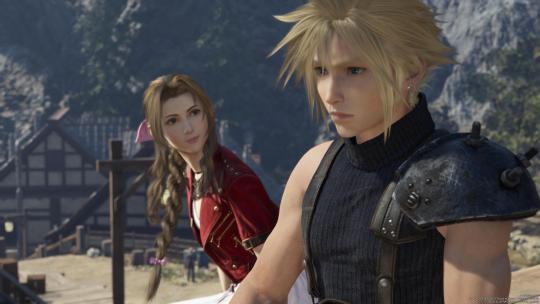
Zack and Aerith’s Long Lost Love / Tragic Love (Canon)
Zack and Aerith’s relationship is the quintessential tragic love story in Final Fantasy VII, defined by separation, longing, and loss. Aerith’s first love, Zack, vanishes from her life without explanation, leaving her with unanswered questions and unresolved feelings. Even as she begins to move forward, her heart never fully lets go of Zack, who is revealed to have fought valiantly to return to her—only to tragically lose his life in the process.
The tragedy of their love lies in the fact that both characters hold onto each other, but fate conspires to keep them apart, making their love story one of the most emotionally poignant elements in the game. Even in death, their connection endures, with Zack and Aerith appearing together in the Lifestream in ACC, symbolizing a love that transcends life itself. This arc, while bittersweet, resolves the narrative of Aerith’s romantic life—Zack was her true love, and Cloud was a reflection of the man she had lost, not a new love interest.
Their tragic love story dispels the myth of a love triangle in Final Fantasy VII, emphasizing that Aerith’s heart always belonged to Zack, even as she developed a bond with Cloud during her journey.

All of the relationships in the game are important. However, Cloud/Tifa & Zack/Aerith are the canon, mutual romantic relationships of Final Fantasy VII. Cloud/Aerith have a cherished friendship, but any romantic subtext of their relationship in the game is used as a vehicle to drive the conflicts and truths of the canon relationships forward. This is accomplished through illusions and subversions in storytelling, as well as creating internal conflict for the characters and canon relationships.
FFVII’s storytelling is deliberately designed to mislead the player through incomplete truths and emotional misdirection, including the use of red herrings, illusions, unreliable narration, and the omission of critical information or context. Cloud’s confused memories and persona, coupled with Aerith’s initial attraction to him based on his similarities to Zack, create the illusion of a romantic triangle, but the deeper truths—Cloud’s unresolved trauma and false identity, Tifa’s role as the keeper of Cloud’s real past and his true feelings, and Aerith’s ultimate fate as the Planet’s protector and her true love being Zack—gradually dismantle this illusionary love triangle.
I cannot stress enough that FFVII is not a love drama or soap opera where the game’s conflict centers on romantic rivalries, betrayal, deception, or morally questionable behaviors.. It’s a complex story that focuses on themes of life, loss, identity, self-discovery, legacy, and on and on.
Love - all kinds of love, including romantic, platonic, and familial - is a theme of FFVII, but truly and holistically, not for the sake of creating meaningless drama between the characters. The relationship dynamics appear messy at times in the earlier parts of the story, but these dynamics are designed to help us reach the proper conclusions about the story and the characters’ arcs, and how true love is a vehicle for reaching resolution for both.
Player’s choice is irrelevant to the plot. You cannot decide or alter the story structure or direction or individual character arcs or relationships. The most you can do is view the game through a slightly different lens by gaining an expanded understanding of character arcs and motivation with new replays.
Shipping is a fandom construct. It’s meant to be fun, and you can ship whatever you like. But shipping doesn’t intersect with the facts of a story or its narrative. Lying about any piece of media to convince yourself or others of its canonicity is bizarre behavior.
Respect the work and its intention, while having your shipping fun within your fandom. Don't embarrass yourself by saying an FF protagonist kissing the girl he’s loved since childhood and joined the army to impress means nothing, or worse, proves he the opposite of a hero.
You can ship your fanon without doing all that.
Last thing: Reunion is a primary theme of Final Fantasy VII. You may have noticed that it is also a primary theme for both of the canon romantic relationships. Personally, I believe that Part Three is going to drive this message home in a way that is unmistakable. I also believe that both lovers' reunions will be instrumental in resolving all of the conflicts of FFVII in the final game.
It’s not a coincidence that both reunions will take place in the Lifestream, or that they've been foreshadowed by the presence of the yellow flower.


I also believe that the dual Rebirth cover arts, described by Tetsuya Nomura as Sephiroth "tearing Cloud and Zack's worlds apart" are heavily foreshadowing the resolution of these relationships along with their connection to the the larger story structures of FFVII/FFVIIR.
Let's wait and see when Part 3 comes along.

#ffvii#cloud strife#cloti#tifa lockhart#final fantasy vii#ffviir#ffvii remake#ffvii rebirth#ltd#love triangle#love triangle debate#shipping discourse#shipping dynamics#shipping drama#shipping discussion#shipping debates
101 notes
·
View notes
Note
About Malleus new years card, given how heavily Japanese culture it goes into. It might be a hagoromo, a white cloth/scarf that floats in the air around a goddess. Given that Malleus is the strongest mage, it might be a symbolism of that. Even so it's used for goddess, Vil and a few others worn clothing meant for women. It wouldn't be unusual to be used for Malleus.
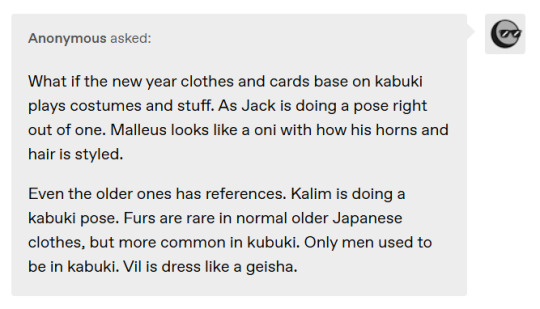

[Referencing this post!]



These asks are all about the fashion of the New Year’s Attire cards and how they relate to Japanese culture, so I thought to combine them ^^
Since I’m responding to three asks in one post and it takes a while to explain things, I’ve placed everything under the cut :> There’s a lot of discussion of Japanese clothing, culture. and folklore in this, so if you’re interested in those topics then you’re in for a treat!!

To the first ask: Though Twst is fairly gender fluid when it comes to dressing its characters, I'm certain that's not a 羽衣 (hagoromo/"feather garment/cloak"; typically worn by celestial women in Japanese mythos). Hagoromo are thinner, longer, and more scarf-like than what is depicted in Malleus's initial card art. You can tell that he's clearly got a sheet that covers his entire body there. The fabric also doesn't appear to be floating like a hagoromo would.
The first two images depict 被衣 (kazuki/katsugi); the latter two images depict 羽衣 (hagoromo); you can see there is a notable visual distinction between them.

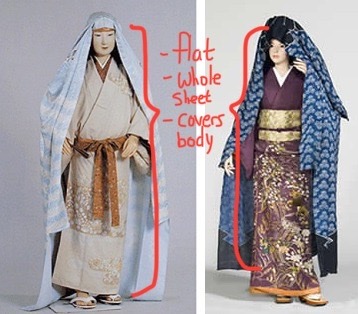



To the second ask: It’s possible that the artists looked at kabuki fashion for inspiration, but they most likely did not base the entirety of the New Year’s Attire outfits on that alone. As Yana states in one March 2023 interview, she and her team try to avoid creating outfits that too closely resemble a single real-world culture or brand. To that end, they seem to pull their inspiration from many different cultures and time periods, which is why you'll see a mixture of traditional and modern Japanese elements in the New Year’s Attire.
歌舞伎 or Kabuki, for those who don't know, is classical form of Japanese theatre which mixes dramatic performances with traditional music and dance. I consulted with a few friends who are familiar with Japanese culture (hereby referred to as A-ko, B-ko, C-ko, and D-ko) about the topic and they had some enlightening information to share. Because I am not familiar with the art form or how to gauge it myself, I will be relaying the information provided by those friends in addition to my own research. A-ko informed me that kabuki used to be co-ed (or at least did feature women; the first kabuki troupe formed was all-women) and modern kabuki is all-men. As for the poses, B-ko remarked that they can be considered common "festival dance poses", not strictly kabuki poses. C-ko added, "[...] There is very little, if anything, kabuki-like about the New Year’s cards apart from possibly SOME of the poses [...] Jack is probably the most kabuki we’re going to get because of the dynamic palm thrust and gaudy composition of his attire." The eye makeup being red and of that design also invokes the image of kabuki makeup without it fully committing to its extravagance!

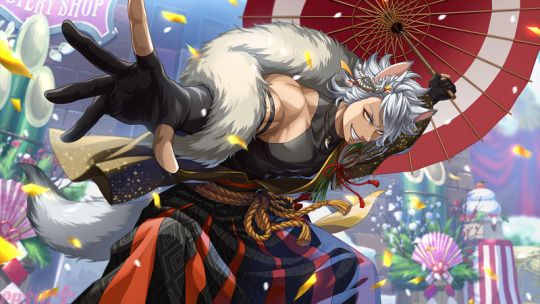

Overall, the group seemed to agree that the New Year’s Attires lack the over-the-top expressions and elaborate costumes of kabuki. There’s also the more obvious lack of full-face stage makeup, but it’s kind of a given that Twst is wouldn’t go this route, especially since the context of these cards is helping out in a store and not putting on a dramatic performance.
On the topic of Malleus and oni (Japanese yōkai, demon, orc, ogre, or troll), I don't think he's intended to look like one??? Sure, he has the horns, but as B-ko said, "[Malleus] always has those horns." Very little in his actual outfit resembles the costume a kabuki actor playing the part of an oni would wear--unless you count the excessive black, as that's a color typically used for oni, but that black is usually paired with red. As for the hair styling, D-ko explained, "Oni usually don't have hair [...]". I find it interesting that some oni masks I found do seem to have hair, but it's usually very sparse omg balding!Malleus real???? and/or a middle part and not the sideways part that Malleus is sporting. Additionally, while oni do have horns, the shape of them is nothing like Malleus’s.

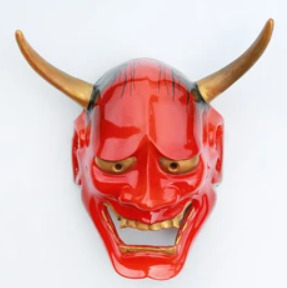

It's true that fur is rarely seen in historical Japanese clothes, but they don't seem to be that common in kabuki either?? According to C-ko, "fur and pelts [...] were a luxury few could afford. Thus, only those people decorated with furs would be royalty or individuals vying for power.
B-ko suggested that the reason why Jack wears fur in his New Year’s Attire isn’t to emulate Kabuki—which tends to feature fluffy wigs, like the one pictured below—but to emphasize his “wolf”-ness and to keep him warm from the cold. C-ko pointed out, however, that “[…] fur accents (like what Jack has) became the trademark for popular and celebrated figures [...] towards the end of the warring states period; when kabuki came into vogue, many plays were inspired by the lives of such personae as well as the legends surrounding them. This is why much of kabuki is characterized by the term basara—of grandeur and ostentatious eccentricity. The actors themselves would not have had access to furs, so they focused instead upon conveying that same sort of energy through their theatrics and outlandish couture. They still used substitutes, of course.” C-ko also added, “The most memorable kabuki roles feature things like fur—which many associate with kabuki.”

Finally, the group altogether said that, “Vil isn’t [dressed like] a geisha. His outfit bears no resemblance to what geisha wears.” 芸者 or Geisha are highly trained Japanese hostesses who entertain guests with song, dance, and conversation—furthermore, there’s a rigorous training process and a very specific appearance they take on. Makeup aside (if Twst is not doing kabuki makeup, why would they do geisha makeup?), a feminine figure and long, flowing kimono is not enough to get the “the look”. B-ko commented, “[…] Calling Vil [dressing like] a geisha just because he wore a feminine kimono […] Like, damn. Does that mean every woman who wears that style [of a] kimono is a geisha now?” It takes considerable time and dedication to achieve this to earn the title; it’s not meant to be taken lightly!
From D-ko, “Overall Vil’s outfit is kinda westernized.” This is due to the hat, gloves, bows, fishnets, and laced collar. A traditional geisha’s outfit lacks the bells and whistles that Vil’s design boasts. The silhouette also seems to be wrong. Why? “Because technically you try to make your silhouette as not curvy as possible when wearing a kimono,” but Vil’s silhouette appears more hourglass-like. The devil is in the details!!
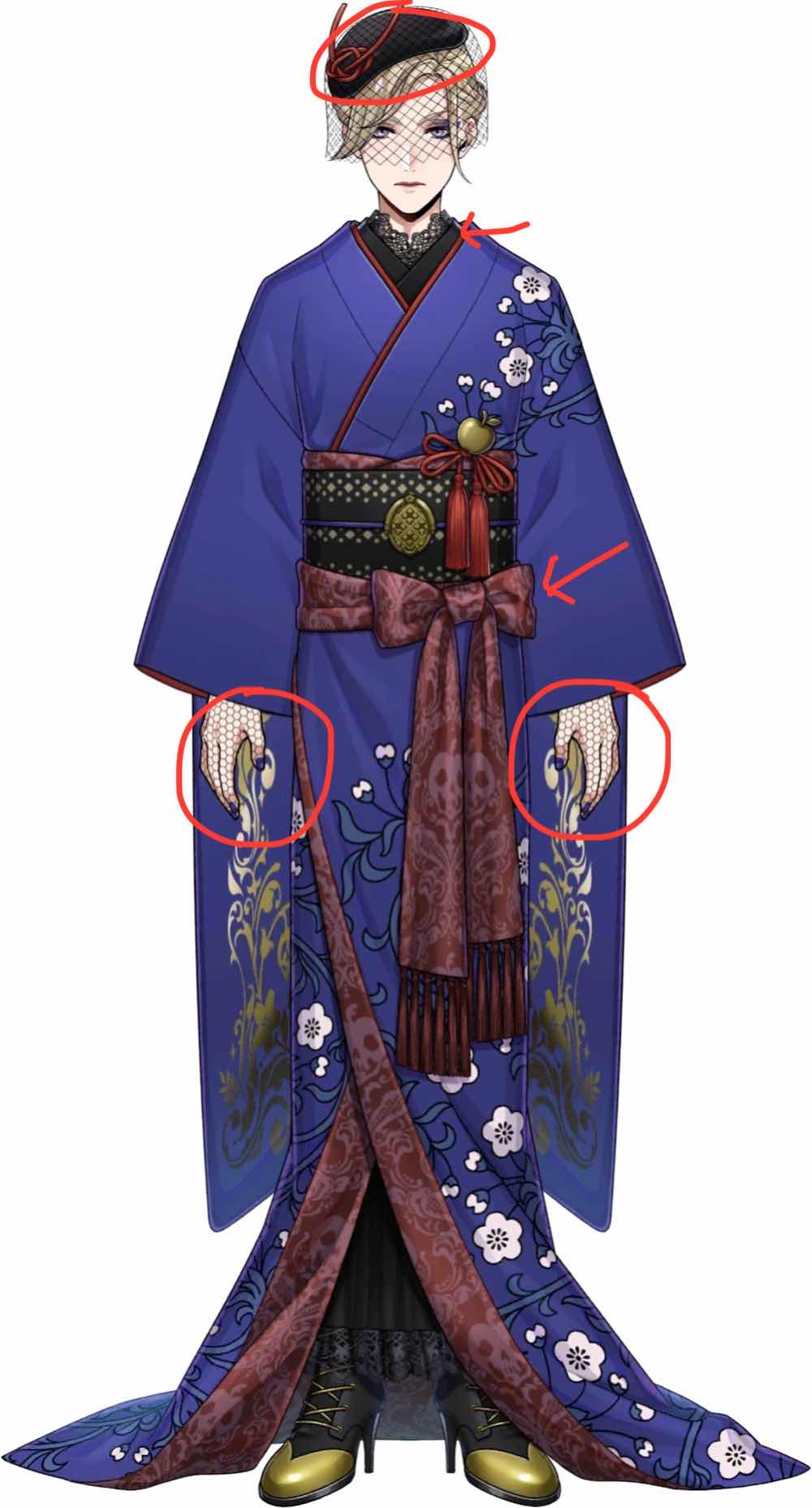





Lastly, to the third ask: Going to skip over talking about Jack's umbrella pose and the kabuki inspiration, since I already addressed that earlier in this post! I'll briefly add that it's not for sure that Malleus is meant to be a certain thing unless Yana and/or her team come out and say it. B-ko agreed, saying "I don't think you can say Malleus is definitely [Ushiwakamaru], since I literally gave [other examples of what] he's dressed like [...] I can understand 'taking inspirations from', though..."
In the final ask, Anon remarks that Jack and Malleus's looks may be inspired by that of 弁慶 (Benkei) and 牛若丸 (Ushiwakamaru), two characters from Japanese folklore. Ushiwakamaru is the nickname of Minamoto no Yoshitsune, who, according to C-ko, "[...] fought and recruited his loyal vassal Benkei in a fabled confrontation on a bridge." While some elements of Jack and Malleus's New Year's Attires resemble what Ushiwakamaru and Benkei are usually depicted wearing--especially Malleus's veil--not all of it matches up. For example, as B-ko notes, "[...] what Malleus is wearing under the veil isn't what Ushiwakamaru is wearing, but looks [like] more of a kannushi (神主/"divine master (of ceremonies; often Shinto clergy)")." B-ko linked this site and recommended checking it out to make clothing comparisons; the kannushi garb was just an item they picked out for similarities on a cursory glance. This brings me back to a point I mentioned in the second ask: Twst's fashion takes inspiration from many sources and blends them.
"I think it really boils down to [Malleus and Jack] evoking the atmosphere of that famous [Ushiwakamaru and Benkei] print," C-ko continues. They drew comparisons between Malleus, a character twisted from Maleficent (commonly depicted with her raven Diablo), and Usiwakamaru, who is the disciple of a tengu {crow/raven yokai). They also compared Jack, a steadfast and virtuous individual, with Benkei, who is a monk with similar traits. Furthermore, in the famous folklore story, Benkei is depicted as having felled 999 men before facing off against Usiwakamaru, a supernatural force. So, like Jack, Benkei is a powerful combatant up against an even more powerful supernatural force, Usiwakamaru/Malleus.


jxxbisbsjJvsjsb I didn’t think we’d be talking about Japanese fashion, history, and folklore to this extent, but here we are 🤩 I hope that, if you’re reading this, maybe you learned something new and interesting from the post!! I know I certainly did while chatting up my friends.
P.S. Thank you to A-ko, B-ko, C-ko, and D-ko for their knowledge and perspectives! Couldn’t have written this without you.
#twisted wonderland#twst#disney twisted wonderland#disney twst#Malleus Draconia#Jack Howl#Vil Schoenheit#notes from the writing raven#jp spoilers#Maleficent#Diablo
117 notes
·
View notes
Note
what is the appeal of ribbun to you? genuinely trying to understand
It's like a fucked up little science experiment
...And now to attempt a serious answer:
For me to enjoy the romantic pairing between two characters beyond occasionally seeing fanart of it, finding it cute, and moving on with my life, there has to be some sort of a conflict in it. Opposing personalities in some way, issues the characters have with each other, issues the characters have with themselves that create issues between each other... also a secret fourth ingredient that I can't describe and is entirely subjective. Call it chemistry.
(For instance I see no romantic chemistry in Funnygummy. They're sweet, they'd make good friends, that's about it for me. I had a whole rant typed out here in a stroke of passion but since I don't want to be the one to judge someone else's comfort ship, I removed it. Plus I dig LollyDolly, so I realized I was starting to sound like a hypocrite.)
I get that canonically, realistically, Gangle might hate Jax. I wouldn't say the same the other way around (perhaps after the latest episode), because I figure Jax must usually enjoy having someone weak-willed to walk all over. He does tease Ragatha the most, the one who reacts with otherwise uncharacteristic anger to his antics, which is plenty amusing, but press a little bit and Gangle folds. She's an easy, weepy target. (Which doesn't mean she never talks back, and I appreciate that.) Meanwhile Gangle in the first three episodes hadn't been getting that much attention from the rest of the cast. Initially it led me to believe that poor soft-spoken sadsack Gangle is for the most part ignored for her issues; they can't help her if her comedy mask is broken, so they just let her be. Thus she gets the most attention from Jax, and not the good kind, but you take what you get... I could see a toxic sort of attachment forming on both sides.
BUT. I don't particularly enjoy the ship when it's one-way abuse. Jax just tormenting Gangle ad nauseum, trotting past all her boundaries, bordering on noncon. Nah, I think she could be a bit unbearable too for karma's sake... and out comes episode four!! Yippee!!
Gangle is every bit the enthusiastic nightmare I was hoping her to be when she's in charge; I was waiting for her to get back at Jax in some way, and boy did she ever. I do prefer a sort of back-and-forth mutuality in my ships, not tipping the scales too far in one way, and anyhow Jax's harrassment of Gangle and lack of comeuppance in the beginning irked me regardless. My Puppeteer AU art I've been making since last summer was supposed to balance out what in the first couple episodes was one-sided torment; also I like fucked up women who are creepily intimate with their victims, so there's that.
(Funnily enough I didn't even ship it before I began drawing more for the AU and studying the two characters. I used to see the ship and think "oh, that's so toxic, I could never". Albeit the fact still hasn't changed that in the AU itself, Gangle's attachment is intended to be platonic.)
Now for taking the ship in a healthier context...
I like the idea of Jax toning himself down for the sake of a relationship, because he's finally realizing he'd rather catch cooties than die alone, and Gangle coming to terms with her abhorrent taste in men but biting the bullet anyway, because it's the circus and they're not exactly rife in options and also because she's a little bit of a freak. As well, arriving some time after one another and forced into proximity by the situation and Jax's pestering of her, they would've come to know each other pretty well. She can guess that there's a lot hiding behind the bunny's mask... which doesn't negate the harm done to her, though. In any case the making of amends would be in order.
If he could bite back his asshole comments for five minutes he might even find himself encouraged to open up a little by a partner who's so vulnerable and expressive of her feelings, however insecure she may be of them. And I also suspect Gangle could be more assertive in private than you'd expect... after all she's shown full capability of retaliating in canon now. I have faith that she could handle herself long-term, granted she develops some more (genuine) confidence.
On a slightly related note, it's unfortunate but interesting to me how much the confidence she does display is conditional. She needs physical objects, the masks, to hype her up, and yet all of what she says and does when wearing them is still coming from herself and only herself. The mask doesn't affect her, she simply adjusts her behavior in tandem with her current expectations. Which reminds me of those kids' cartoon episodes where the gained self-esteem and power the protagonist attributed to an object or keepsake was inside them all along.
These expectations can be a burden as well, and she's better off getting rid of the happy mask in the end. The lack of pressure to take charge can be reassuring if that's something you don't feel comfortable doing.
And when it comes to Jax, it may also be that she normally just... doesn't want to exert the energy to snap back at him. A constant battle with someone who insists on being an active dick to you but you can't get rid of sounds exhausting. It's easier to keep to yourself and go along with it, and as someone who also tends to take the easy way, I get that. Especially since it wouldn't even make a difference. It's not like she had any means of truly punishing him for his actions before being placed in a position of power during Fast Food Masquerade. (Good for her.)
In all my AUs where I am receptive to Ribbun, I make sure to level the playing field. Since it's hard to imagine Jax being much kinder, she should get to at least irritate him equally in return. She can be cringe and annoying and a handful too, as a treat.
Ultimately they're still gonna like each other, or else what's the point? But the clashing of their personalities adds a dash of spice to it.
Anyway this got long, maybe because the passive-aggression I've picked up from this anon message compelled me, intentional or not, to elaborate beyond the first sentence. I think it's the fact that I'm pretty sure I've seen a Ribbun shipper I follow questioned likewise almost word for word, I don't know how long ago, as if indulging in this ship is a uniquely baffling and suspicious activity that must be questioned. Regardless there you have my attempt at an explanation, a.k.a my slapdash pile of barely connected ideas.
(P.S it's not even my favorite ship involving either of these characters. But I've come to acknowledge it's got its own tasty flavor, toxic or not.)
#💌 rory answers#ribbun#yaaay I finished it after three days#this was the FIRST ask I got in 2025 at the strike of midnight so I knew I had to sit on it a little more
57 notes
·
View notes
Text
I've been wondering why I get so steamed over anons asking about 'what happened?' to writers in fandoms, and I think I've narrowed it down to the fact that generally, those who keep in touch with fandom writers, or other creators, don't need to ask 'what happend'.... Because they usually are already keeping tabs or trying to support their favorite blogs in some way.
Most writers I know, I loosely know what they're into nowadays or why they may not be writing. you can usually tell by context clues - or by the fact most writers and other creators are rather chatty (to many of us, creating was just another form of reaching out!) and we generally...post about it.
We discuss that writing, or translations, or art, or more are 'on hold' because IRL got busy, our jobs stressed us out.
We talk about other games we've gotten into, how much fun we're having with a new hobby, we talk about how we wish more people would reach out to us more concerning this and that. Hell, a lot of creators I know, and just other fandom folks, are pretty desperate to talk - we make whole worlds or submerge ourselves into them for human connections for fucks sake - there are usually signs of some sort, if you actually look.
even if its not a very clear cut post saying 'hey, im getting tired, I want to take a break' - you can see this by all of the works on their masterlist. how many years they've been talking and writing and making things about xyz. the new shiny interest they have that's revived their spark. the hints of a sideblog, the hints of IRL holding more interest now that they're no longer stuck in a trauma home.
i feel as though its very rare to not be able to piece together where a creator has 'gone'. It's pretty rare for people to just poof away randomly.
it bothers me. "Where did all the [fandom] writers go?" just directly translates to "i dont actually care, where is content?" because generally... if you interact with the writers and blogs you love so much, you'd know 95% of the time, or could hazard a safe guess.
The question also showcases that lack of support newer fandom writers are likely receiving as well (fandom writers still exist!!! New blogs writing for these games still pop up!!!!!), however I can't really discuss that too in depth and think they should talk about their struggles and be supported on that too.
LOOK in the fandom. They still fucking exist.
#scum talks#scum rants#even i am aware that most of the time my own feeling of lack of fandomisms is because ive lost energy to interact#but i take the time to at least quietly check on people. to leave likes. to comment when I can.#i dont need to ask where the writers are because ive watched them fall in love with other games or passions#or had fun writing for a while and decided to stay offline and bid people farewell#i promise that most writers or creators or bloggers you miss likely have said where they are. or would answer a KIND message fast/soon
40 notes
·
View notes
Text
The programmer Simon Willison has described the training for large language models as “money laundering for copyrighted data,” which I find a useful way to think about the appeal of generative-A.I. programs: they let you engage in something like plagiarism, but there’s no guilt associated with it because it’s not clear even to you that you’re copying. Some have claimed that large language models are not laundering the texts they’re trained on but, rather, learning from them, in the same way that human writers learn from the books they’ve read. But a large language model is not a writer; it’s not even a user of language. Language is, by definition, a system of communication, and it requires an intention to communicate. Your phone’s auto-complete may offer good suggestions or bad ones, but in neither case is it trying to say anything to you or the person you’re texting. The fact that ChatGPT can generate coherent sentences invites us to imagine that it understands language in a way that your phone’s auto-complete does not, but it has no more intention to communicate. It is very easy to get ChatGPT to emit a series of words such as “I am happy to see you.” There are many things we don’t understand about how large language models work, but one thing we can be sure of is that ChatGPT is not happy to see you. A dog can communicate that it is happy to see you, and so can a prelinguistic child, even though both lack the capability to use words. ChatGPT feels nothing and desires nothing, and this lack of intention is why ChatGPT is not actually using language. What makes the words “I’m happy to see you” a linguistic utterance is not that the sequence of text tokens that it is made up of are well formed; what makes it a linguistic utterance is the intention to communicate something. Because language comes so easily to us, it’s easy to forget that it lies on top of these other experiences of subjective feeling and of wanting to communicate that feeling. We’re tempted to project those experiences onto a large language model when it emits coherent sentences, but to do so is to fall prey to mimicry; it’s the same phenomenon as when butterflies evolve large dark spots on their wings that can fool birds into thinking they’re predators with big eyes. There is a context in which the dark spots are sufficient; birds are less likely to eat a butterfly that has them, and the butterfly doesn’t really care why it’s not being eaten, as long as it gets to live. But there is a big difference between a butterfly and a predator that poses a threat to a bird. A person using generative A.I. to help them write might claim that they are drawing inspiration from the texts the model was trained on, but I would again argue that this differs from what we usually mean when we say one writer draws inspiration from another. Consider a college student who turns in a paper that consists solely of a five-page quotation from a book, stating that this quotation conveys exactly what she wanted to say, better than she could say it herself. Even if the student is completely candid with the instructor about what she’s done, it’s not accurate to say that she is drawing inspiration from the book she’s citing. The fact that a large language model can reword the quotation enough that the source is unidentifiable doesn’t change the fundamental nature of what’s going on. As the linguist Emily M. Bender has noted, teachers don’t ask students to write essays because the world needs more student essays. The point of writing essays is to strengthen students’ critical-thinking skills; in the same way that lifting weights is useful no matter what sport an athlete plays, writing essays develops skills necessary for whatever job a college student will eventually get. Using ChatGPT to complete assignments is like bringing a forklift into the weight room; you will never improve your cognitive fitness that way.
31 August 2024
106 notes
·
View notes
Text
Balancing Show and Tell in Writing
I’ve touched on this topic before, but in this post, I’ll dive deeper into the art of balancing show and tell. If you’re just starting out or looking to refine your writing skills, you’ve come to the right place!
Showing and telling is a fundamental aspect of writing because it forms the building blocks of an effective plot. When done well, it gives your story its purpose and immerses your readers in the world you’ve created. Below, we’ll explore what it means to tell and to show, along with tips for finding the right balance.
Examples of Telling
Telling statements are simple and factual, but they lack depth and engagement. For example:
- The wind blew.
- The grass grew.
- The sky changed color.
- That person smelled bad.
These statements merely relay information and don’t evoke much emotion or imagery. While they serve a purpose in writing, overusing them can make your story feel flat.
Examples of Showing
Showing statements, on the other hand, add vivid detail and context, helping readers visualize the scene and feel connected to it. For instance:
- The wind blew through my hair as I walked to work.
- The grass had grown a foot since my last visit—it was nearly up to my knees.
- The sky shifted from blue to a breathtaking mix of purple and pink.
- My teammate smelled of sweat after practice.
These examples provide depth and allow readers to experience the moment with the character. By showing rather than simply telling, you invite readers into your story and keep them engaged.
How to Balance Show and Tell
Balancing show and tell is crucial to your story’s success. Knowing when to show and when to tell will help you create a dynamic, compelling narrative. Here are some tips:
- Dialogue: When characters talk about past experiences, telling can work well—it’s often the natural way people communicate. However, if you want a character to help others visualize the moment, consider blending show and tell.
- Scenes: For characters experiencing something new or stepping into a different environment, showing is key to immersing your readers. Use sensory details and actions to paint a vivid picture.
- Efficiency: Sometimes, telling is more effective for moving the plot forward. For example, a brief, factual statement can help bridge scenes without bogging down the narrative with unnecessary detail.
Balancing show and tell might feel challenging at first, but as with any writing skill, practice makes perfect.
Show and Tell Used Effectively
Want to see show and tell in action? One of the best ways to observe this balance is through horror movies or books. These genres often rely on both techniques to build suspense and deliver emotional impact. For instance, a horror film might show a character nervously glancing over their shoulder (visualizing fear) and then tell us their internal thoughts (“Something didn’t feel right”).
Conclusion
Show and tell are essential tools for crafting memorable stories. Knowing when to show and when to tell can elevate your writing, making it more engaging and impactful. Remember, showing immerses your readers in the moment, while telling keeps the narrative focused and clear. Mastering this balance takes time, but with practice, you’ll find your rhythm.
Happy writing!
#writing tips#show dont tell#creative writing#storytellingadvice#writerslife#amwriting#writing skills#fiction writing#writing community#writing process#writingjourney#character development
34 notes
·
View notes